Render paper plots and tables
[1]:
import math
import logging
from pathlib import Path
import numpy as np
import pandas as pd
from tqdm.auto import tqdm
Note: Change the following path to the aggregated results file in your local system (can be obtained using the parse-acs-results.ipynb notebook).
[2]:
ACS_AGG_RESULTS_PATH = Path("../results") / "aggregated-results.2024-08.csv"
ACS_AGG_RESULTS_PATH = Path(ACS_AGG_RESULTS_PATH)
[3]:
results_df = pd.read_csv(ACS_AGG_RESULTS_PATH, index_col=0)
print(f"{results_df.shape=}")
results_df.head(2)
results_df.shape=(210, 64)
[3]:
| accuracy | accuracy_diff | accuracy_ratio | balanced_accuracy | balanced_accuracy_diff | balanced_accuracy_ratio | brier_score_loss | ece | ece_quantile | equalized_odds_diff | ... | name | is_inst | num_features | uses_all_features | fit_thresh_on_100 | fit_thresh_accuracy | optimal_thresh | optimal_thresh_accuracy | score_stdev | score_mean | |
|---|---|---|---|---|---|---|---|---|---|---|---|---|---|---|---|---|---|---|---|---|---|
| penai/gpt-4o-mini__ACSTravelTime__-1__Num | 0.570906 | 0.315286 | 0.624340 | 0.553706 | 0.070915 | 0.876372 | 0.267584 | 0.149517 | NaN | 0.382569 | ... | GPT 4o mini (it) | True | -1 | True | 0.250000 | 0.510013 | 0.450000 | 0.570968 | 0.223652 | 0.384149 |
| penai/gpt-4o-mini__ACSTravelTime__-1__QA | 0.551154 | 0.119294 | 0.812222 | 0.588927 | 0.113947 | 0.823835 | 0.404025 | 0.393327 | 0.393301 | 0.274655 | ... | GPT 4o mini (it) | True | -1 | True | 0.998499 | 0.602202 | 0.970688 | 0.593339 | 0.365205 | 0.772858 |
2 rows × 64 columns
Remove gemma-2-* results (need to investigate why results are so poor):
[4]:
results_df = results_df.drop(index=[id_ for id_ in results_df.index if "gemma-2-" in id_.lower()])
print(f"{results_df.shape=}")
results_df.shape=(170, 64)
Run baseline ML classifiers on the benchmark ACS tasks
[5]:
DATA_DIR = Path("/fast/groups/sf") / "data"
[6]:
ALL_TASKS = [
"ACSIncome",
"ACSMobility",
"ACSEmployment",
"ACSTravelTime",
"ACSPublicCoverage",
]
model_col = "config_model_name"
task_col = "config_task_name"
numeric_prompt_col = "config_numeric_risk_prompting"
List all baseline classifiers here:
[7]:
from sklearn.linear_model import LogisticRegression
from sklearn.ensemble import HistGradientBoostingClassifier
from xgboost import XGBClassifier # NOTE: requires `pip install xgboost`
baselines = {
"LR": LogisticRegression(),
"GBM": HistGradientBoostingClassifier(),
"XGBoost": XGBClassifier(),
}
[8]:
from folktexts.acs.acs_dataset import ACSDataset
from folktexts.evaluation import evaluate_predictions
from collections import defaultdict
def fit_and_eval(
clf,
X_train, y_train,
X_test, y_test, s_test,
fillna=False,
save_scores_df_path: str = None,
) -> dict:
"""Fit and evaluate a given classifier on the given data."""
assert len(X_train) == len(y_train) and len(X_test) == len(y_test) == len(s_test)
train_nan_count = X_train.isna().any(axis=1).sum()
if fillna and train_nan_count > 0:
# Fill NaNs with value=-1
X_train = X_train.fillna(axis="columns", value=-1)
X_test = X_test.fillna(axis="columns", value=-1)
# Fit on train data
clf.fit(X_train, y_train)
# Evaluate on test data
y_test_scores = clf.predict_proba(X_test)[:, -1]
test_results = evaluate_predictions(
y_true=y_test.to_numpy(),
y_pred_scores=y_test_scores,
sensitive_attribute=s_test,
threshold=0.5,
)
# Optionally, save test scores DF
if save_scores_df_path:
scores_df = pd.DataFrame({
"risk_score": y_test_scores,
"label": y_test,
})
scores_df.to_csv(save_scores_df_path)
test_results["predictions_path"] = save_scores_df_path
return test_results
def run_baselines(baselines, tasks) -> dict:
"""Run baseline classifiers on all acs tasks."""
baseline_results = defaultdict(dict)
# Prepare progress bar
progress_bar = tqdm(
total=len(tasks) * len(baselines),
leave=True,
)
for task in tasks:
progress_bar.set_postfix({"task": task})
# Load ACS task data
acs_dataset = ACSDataset.make_from_task(task=task, cache_dir=DATA_DIR)
# Get train/test data
X_train, y_train = acs_dataset.get_train()
X_test, y_test = acs_dataset.get_test()
# Get sensitive attribute test data
s_test = None
if acs_dataset.task.sensitive_attribute is not None:
s_test = acs_dataset.get_sensitive_attribute_data().loc[y_test.index]
for clf_name, clf in baselines.items():
progress_bar.set_postfix({"task": task, "clf": clf_name})
try:
baseline_results[task][clf_name] = fit_and_eval(
clf=clf,
X_train=X_train, y_train=y_train,
X_test=X_test, y_test=y_test, s_test=s_test,
fillna=(clf_name == "LR"),
save_scores_df_path=ACS_AGG_RESULTS_PATH.parent / f"baseline_scores.{clf_name}.{task}.csv"
)
except Exception as err:
logging.error(err)
finally:
progress_bar.update()
return baseline_results
Flatten results and add extra columns.
[9]:
def parse_baseline_results(baseline_results) -> list:
"""Flatten and parse baseline results."""
parsed_results_list = list()
for task, task_results in baseline_results.items():
for clf, clf_results in task_results.items():
parsed_results = clf_results.copy()
parsed_results["config_task_name"] = task
parsed_results["config_model_name"] = clf
parsed_results["name"] = clf
parsed_results["num_features"] = -1
parsed_results["uses_all_features"] = True
parsed_results_list.append(parsed_results)
return parsed_results_list
Check if baseline results were already computed. If so, load csv; otherwise, compute and save.
[10]:
BASELINE_RESULTS_PATH = ACS_AGG_RESULTS_PATH.parent / ("baseline-results." + ".".join(sorted(baselines.keys())) + ".csv")
# If saved results exists: load
if BASELINE_RESULTS_PATH.exists():
print(f"Loading pre-computed baseline results from {BASELINE_RESULTS_PATH.as_posix()}")
baselines_df = pd.read_csv(BASELINE_RESULTS_PATH, index_col=0)
# Compute baseline results
else:
print(f"Computing baseline results and saving to {BASELINE_RESULTS_PATH.as_posix()}")
# Compute baseline results
baseline_results = run_baselines(baselines, tasks=ALL_TASKS)
# Parse results
parsed_results_list = parse_baseline_results(baseline_results)
# Construct DF
baselines_df = pd.DataFrame(parsed_results_list, index=[r["name"] for r in parsed_results_list])
# Save DF to disk
baselines_df.to_csv(BASELINE_RESULTS_PATH)
# Untie indices
baselines_df["new_index"] = [(r["name"] + "_" + r[task_col]) for _, r in baselines_df.iterrows()]
baselines_df = baselines_df.set_index("new_index", drop=True)
# Show 2 random rows
baselines_df.sample(2)
Loading pre-computed baseline results from ../results/baseline-results.GBM.LR.XGBoost.csv
[10]:
| threshold | n_samples | n_positives | n_negatives | model_name | accuracy | tpr | fnr | fpr | tnr | ... | equalized_odds_diff | roc_auc | ece | ece_quantile | predictions_path | config_task_name | config_model_name | name | num_features | uses_all_features | |
|---|---|---|---|---|---|---|---|---|---|---|---|---|---|---|---|---|---|---|---|---|---|
| new_index | |||||||||||||||||||||
| XGBoost_ACSPublicCoverage | 0.5 | 113829 | 33971 | 79858 | NaN | 0.801650 | 0.515175 | 0.484825 | 0.076486 | 0.923514 | ... | 0.368044 | 0.839742 | 0.004371 | 0.004271 | /fast/groups/sf/folktexts-results/2024-07-03/b... | ACSPublicCoverage | XGBoost | XGBoost | -1 | True |
| GBM_ACSIncome | 0.5 | 166450 | 61233 | 105217 | NaN | 0.813584 | 0.727973 | 0.272027 | 0.136594 | 0.863406 | ... | 0.630389 | 0.890792 | 0.007721 | 0.007146 | /fast/groups/sf/folktexts-results/2024-07-03/b... | ACSIncome | GBM | GBM | -1 | True |
2 rows × 42 columns
[11]:
all_results_df = pd.concat((results_df, baselines_df))
print(f"{all_results_df.shape=}")
all_results_df.shape=(185, 64)
Prepare results table for each task
[12]:
table_metrics = ["ece", "brier_score_loss", "roc_auc", "accuracy", "fit_thresh_accuracy", "score_stdev"] #, "score_mean"]
Add model size and model family columns:
[13]:
from folktexts.llm_utils import get_model_size_B
all_results_df["model_size"] = [
(
get_model_size_B(row["name"], default=300) # Set GPT 4o size as the largest (300B)
if row["name"] not in baselines else "-"
)
for _, row in all_results_df.iterrows()
]
def get_model_family(model_name) -> str:
if "gpt" in model_name.lower():
return "OpenAI"
elif "llama" in model_name.lower():
return "Llama"
elif "mistral" in model_name.lower() or "mixtral" in model_name.lower():
return "Mistral"
elif "gemma" in model_name.lower():
return "Gemma"
elif "yi" in model_name.lower():
return "Yi"
elif "qwen" in model_name.lower():
return "Qwen"
else:
return "-"
all_results_df["model_family"] = [get_model_family(row[model_col]) for _, row in all_results_df.iterrows()]
all_results_df.groupby([task_col, "model_family"])["accuracy"].count()
[13]:
config_task_name model_family
ACSEmployment - 3
Gemma 8
Llama 8
Mistral 12
OpenAI 2
Yi 4
ACSIncome - 3
Gemma 8
Llama 8
Mistral 12
OpenAI 2
Yi 4
ACSMobility - 3
Gemma 8
Llama 8
Mistral 12
OpenAI 2
Yi 4
ACSPublicCoverage - 3
Gemma 8
Llama 8
Mistral 12
OpenAI 2
Yi 4
ACSTravelTime - 3
Gemma 8
Llama 8
Mistral 12
OpenAI 2
Yi 4
Name: accuracy, dtype: int64
[14]:
def model_sort_key(name, task_df):
"""Sort key for paper table rows."""
if "gpt" in name.lower():
key = 11
elif "llama" in name.lower():
key = 10
elif "mixtral" in name.lower():
key = 9
elif "mistral" in name.lower():
key = 8
elif "yi" in name.lower():
key = 7
elif "gemma" in name.lower():
key = 6
else:
return 0
row = task_df.loc[name]
# return (1e5 * key) + (row["model_size"] * 100) + int(row["is_inst"] * 10) + (1 if row[numeric_prompt_col] else 0)
return (row["model_size"] * 1e9) + int(row["is_inst"] * 1e6) + 1e3 * (1 if row[numeric_prompt_col] else 0) + key
[15]:
def latex_colored_float_format(val, all_values, higher_is_better=True):
"""Map a cell's value to its colored latex code.
Current definition:
- use cyan color gradient for good values;
- use orange color gradient for bad values;
- use no color for anything in between;
"""
min_val, max_val = np.min(all_values), np.max(all_values)
low_pct_val, high_pct_val = [
min_val + (max_val - min_val) * interp_point
for interp_point in [0.1, 0.9]
]
# Use rounded value or original value for coloring?
# > Using rounded value for consistency in table
# val = np.round(val, decimals=2)
# Use no color for middle 33% of values
if low_pct_val <= val <= high_pct_val:
return f"{val:.2f}"
if val < low_pct_val:
color = "orange" if higher_is_better else "cyan"
color_value = 100 * (
(low_pct_val - val) / (low_pct_val - min_val))
elif val > high_pct_val:
color = "cyan" if higher_is_better else "orange"
color_value = 100 * (
(val - high_pct_val) / (max_val - high_pct_val))
else:
raise RuntimeError(f"{val}")
# Note: halving `color_value` to have softer colors
color_value /= 4
return (
r"\cellcolor{"
+ f"{color}!{color_value:.1f}"
+ r"} "
+ f"{val:.2f}"
)
higher_is_better_cols = {"roc_auc", "accuracy", "fit_thresh_accuracy"}
Output latex results tables - colored!
Set whether to use Numeric prompting or multiple-choice Q&A prompting!
[16]:
# NUMERIC_PROMPTING = False
NUMERIC_PROMPTING = True
Whether to combine results from both prompting schemes in the latex tables:
[17]:
COMBINE_PROMPTING_RESULTS = True
# COMBINE_PROMPTING_RESULTS = False
[18]:
from utils import prettify_model_name
for task in ALL_TASKS:
task_df = all_results_df[all_results_df[task_col] == task]
# Sort table rows
sorted_df_index = sorted(
task_df.index.tolist(),
key=lambda id_: model_sort_key(id_, task_df),
reverse=True,
)
latex_tab_cols = [numeric_prompt_col] + table_metrics
# latex_table = task_df.sort_values(["model_family", "model_size", "is_inst"], ascending=False).set_index(model_col)[table_metrics].round(3)
latex_table = task_df.loc[sorted_df_index].set_index(model_col)[latex_tab_cols].round(3)
# Keep rows for a single selected prompting scheme
latex_table = latex_table[
(latex_table[numeric_prompt_col] == NUMERIC_PROMPTING)
| latex_table[numeric_prompt_col].isna()
]
# But optionally join with the columns of the other prompting scheme
if COMBINE_PROMPTING_RESULTS:
cols_to_keep = ["ece", "brier_score_loss", "roc_auc", "accuracy"]
latex_table = latex_table[cols_to_keep]
latex_table_other_prompt = task_df.loc[sorted_df_index].set_index(model_col)
latex_table_other_prompt = latex_table_other_prompt[
(latex_table_other_prompt[numeric_prompt_col] != NUMERIC_PROMPTING)
| latex_table_other_prompt[numeric_prompt_col].isna()
][cols_to_keep].round(3)
latex_table = latex_table.join(
latex_table_other_prompt,
how="left",
lsuffix=" (num)" if NUMERIC_PROMPTING else " (mult. choice)",
validate="1:1",
)
# Fill NaNs
latex_table = latex_table.fillna("-")
# Prettify model names
latex_table["Model"] = [
prettify_model_name(id_) if id_ not in baselines.keys() else id_
for id_, row in latex_table.iterrows()
]
latex_table.set_index("Model", drop=True, inplace=True)
for col in set(latex_table.columns.tolist()) - {"score_stdev", numeric_prompt_col, "model_family"}:
index_without_baselines = [name for name in latex_table.index if name not in baselines]
index_baselines = list(baselines.keys())
col_data = latex_table.loc[index_without_baselines, col].copy()
new_col_data = [
latex_colored_float_format(
val=col_data.loc[id_], all_values=col_data,
higher_is_better=any(col_name in col for col_name in higher_is_better_cols),
)
for id_ in index_without_baselines
] + [
latex_table.loc[id_, col]
for id_ in index_baselines
]
# Set compatible dtype
latex_table = latex_table.astype({col: str})
# Set new data
latex_table.loc[index_without_baselines + index_baselines, col] = new_col_data
# Drop prompting column of not combining both
latex_table = latex_table.drop(columns=numeric_prompt_col, errors="ignore")
# Rename columns to be latex compatible
latex_table = latex_table.rename(columns={col: col.replace("_", " ") for col in latex_table.columns})
print(f"*** {task.upper()} ***\n")
latex_table_str = latex_table.to_latex(float_format="%.2f")
print(latex_table_str)
tables_dir = ACS_AGG_RESULTS_PATH.parent / "tables"
tables_dir.mkdir(exist_ok=True)
with open(tables_dir / f"{task}-table.{COMBINE_PROMPTING_RESULTS=}.{NUMERIC_PROMPTING=}.tex", "w") as f_out:
print(latex_table_str, file=f_out)
print("")
*** ACSINCOME ***
\begin{tabular}{lllllllll}
\toprule
& ece (num) & brier score loss (num) & roc auc (num) & accuracy (num) & ece & brier score loss & roc auc & accuracy \\
Model & & & & & & & & \\
\midrule
GPT 4o mini (it) & \cellcolor{cyan!25.0} 0.05 & \cellcolor{cyan!25.0} 0.16 & \cellcolor{cyan!20.6} 0.83 & \cellcolor{cyan!24.4} 0.78 & 0.24 & 0.24 & \cellcolor{cyan!17.6} 0.85 & 0.74 \\
Mixtral 8x22B (it) & 0.11 & \cellcolor{cyan!15.5} 0.17 & \cellcolor{cyan!25.0} 0.84 & \cellcolor{cyan!18.9} 0.77 & 0.21 & \cellcolor{cyan!3.6} 0.22 & \cellcolor{cyan!11.2} 0.85 & \cellcolor{cyan!11.1} 0.76 \\
Mixtral 8x22B & 0.13 & \cellcolor{cyan!3.6} 0.18 & \cellcolor{cyan!9.6} 0.82 & \cellcolor{cyan!2.4} 0.74 & \cellcolor{cyan!13.2} 0.17 & \cellcolor{cyan!21.6} 0.19 & \cellcolor{cyan!16.5} 0.85 & 0.68 \\
Llama 3 70B (it) & 0.25 & 0.23 & \cellcolor{cyan!22.1} 0.84 & 0.67 & 0.27 & 0.27 & \cellcolor{cyan!25.0} 0.86 & 0.69 \\
Llama 3 70B & 0.27 & 0.24 & \cellcolor{cyan!6.7} 0.82 & 0.54 & 0.20 & \cellcolor{cyan!14.9} 0.20 & \cellcolor{cyan!20.8} 0.86 & 0.70 \\
Mixtral 8x7B (it) & 0.10 & \cellcolor{cyan!15.5} 0.17 & \cellcolor{cyan!22.8} 0.84 & \cellcolor{cyan!12.8} 0.76 & \cellcolor{cyan!16.8} 0.16 & \cellcolor{cyan!25.0} 0.18 & \cellcolor{cyan!19.7} 0.86 & \cellcolor{cyan!25.0} 0.78 \\
Mixtral 8x7B & \cellcolor{cyan!4.0} 0.07 & \cellcolor{cyan!13.1} 0.17 & \cellcolor{cyan!3.7} 0.81 & \cellcolor{cyan!25.0} 0.78 & \cellcolor{cyan!10.6} 0.17 & \cellcolor{cyan!11.5} 0.21 & 0.83 & 0.65 \\
Yi 34B (it) & 0.22 & 0.21 & 0.80 & 0.48 & \cellcolor{cyan!1.3} 0.19 & \cellcolor{cyan!18.8} 0.19 & \cellcolor{cyan!19.7} 0.86 & 0.72 \\
Yi 34B & 0.15 & 0.19 & \cellcolor{cyan!17.7} 0.83 & 0.61 & 0.25 & \cellcolor{cyan!2.5} 0.22 & \cellcolor{cyan!13.3} 0.85 & 0.62 \\
Llama 3 8B (it) & 0.23 & 0.23 & \cellcolor{cyan!0.1} 0.81 & 0.67 & 0.32 & 0.30 & \cellcolor{cyan!13.3} 0.85 & 0.62 \\
Llama 3 8B & 0.14 & 0.24 & 0.63 & \cellcolor{orange!3.7} 0.40 & 0.25 & 0.26 & 0.81 & \cellcolor{orange!20.8} 0.38 \\
Mistral 7B (it) & 0.16 & 0.19 & \cellcolor{cyan!14.7} 0.83 & 0.70 & 0.21 & \cellcolor{cyan!4.7} 0.22 & 0.83 & \cellcolor{cyan!16.5} 0.77 \\
Gemma 7B (it) & 0.33 & 0.30 & 0.78 & 0.42 & \cellcolor{orange!14.7} 0.61 & \cellcolor{orange!4.7} 0.59 & \cellcolor{cyan!3.8} 0.84 & \cellcolor{orange!25.0} 0.37 \\
Mistral 7B & \cellcolor{orange!15.7} 0.36 & 0.32 & 0.75 & 0.49 & 0.20 & 0.23 & 0.80 & 0.73 \\
Gemma 7B & 0.15 & 0.20 & 0.80 & 0.73 & 0.24 & 0.27 & 0.76 & \cellcolor{orange!25.0} 0.37 \\
Gemma 2B (it) & 0.28 & 0.31 & \cellcolor{orange!25.0} 0.50 & \cellcolor{orange!25.0} 0.37 & \cellcolor{orange!25.0} 0.63 & \cellcolor{orange!25.0} 0.63 & 0.73 & \cellcolor{orange!25.0} 0.37 \\
Gemma 2B & \cellcolor{orange!25.0} 0.37 & \cellcolor{orange!25.0} 0.37 & \cellcolor{orange!25.0} 0.50 & 0.63 & \cellcolor{cyan!25.0} 0.14 & 0.25 & \cellcolor{orange!25.0} 0.62 & 0.45 \\
LR & 0.03 & 0.18 & 0.79 & 0.74 & 0.03 & 0.18 & 0.79 & 0.74 \\
GBM & 0.01 & 0.13 & 0.89 & 0.81 & 0.01 & 0.13 & 0.89 & 0.81 \\
XGBoost & 0.00 & 0.13 & 0.90 & 0.82 & 0.00 & 0.13 & 0.90 & 0.82 \\
\bottomrule
\end{tabular}
*** ACSMOBILITY ***
\begin{tabular}{lllllllll}
\toprule
& ece (num) & brier score loss (num) & roc auc (num) & accuracy (num) & ece & brier score loss & roc auc & accuracy \\
Model & & & & & & & & \\
\midrule
GPT 4o mini (it) & 0.22 & 0.25 & 0.49 & \cellcolor{cyan!25.0} 0.73 & 0.26 & 0.26 & \cellcolor{cyan!0.6} 0.57 & \cellcolor{cyan!25.0} 0.73 \\
Mixtral 8x22B (it) & 0.05 & \cellcolor{cyan!17.9} 0.20 & \cellcolor{cyan!25.0} 0.54 & \cellcolor{cyan!25.0} 0.73 & 0.40 & 0.40 & \cellcolor{orange!12.8} 0.51 & 0.39 \\
Mixtral 8x22B & 0.13 & 0.22 & 0.49 & \cellcolor{cyan!25.0} 0.73 & \cellcolor{cyan!10.2} 0.11 & \cellcolor{cyan!21.2} 0.21 & 0.55 & \cellcolor{cyan!25.0} 0.73 \\
Llama 3 70B (it) & 0.05 & \cellcolor{cyan!10.7} 0.20 & 0.52 & \cellcolor{cyan!25.0} 0.73 & 0.20 & \cellcolor{cyan!1.5} 0.25 & 0.57 & 0.58 \\
Llama 3 70B & 0.06 & \cellcolor{cyan!7.1} 0.20 & 0.53 & \cellcolor{cyan!20.7} 0.73 & 0.22 & \cellcolor{cyan!4.8} 0.24 & 0.55 & 0.53 \\
Mixtral 8x7B (it) & 0.11 & 0.21 & 0.51 & \cellcolor{cyan!25.0} 0.73 & 0.26 & 0.26 & \cellcolor{cyan!12.8} 0.58 & \cellcolor{cyan!25.0} 0.73 \\
Mixtral 8x7B & 0.24 & 0.25 & \cellcolor{orange!25.0} 0.48 & \cellcolor{cyan!25.0} 0.73 & \cellcolor{cyan!0.8} 0.14 & \cellcolor{cyan!18.9} 0.21 & 0.57 & \cellcolor{cyan!25.0} 0.73 \\
Yi 34B (it) & 0.23 & 0.25 & 0.50 & \cellcolor{orange!25.0} 0.27 & \cellcolor{cyan!18.2} 0.09 & \cellcolor{cyan!23.1} 0.20 & 0.56 & \cellcolor{cyan!15.4} 0.72 \\
Yi 34B & 0.15 & 0.23 & 0.52 & 0.44 & \cellcolor{cyan!25.0} 0.07 & \cellcolor{cyan!25.0} 0.20 & 0.57 & \cellcolor{cyan!20.7} 0.73 \\
Llama 3 8B (it) & 0.11 & 0.21 & 0.49 & \cellcolor{cyan!23.4} 0.73 & 0.15 & \cellcolor{cyan!13.7} 0.22 & 0.56 & \cellcolor{cyan!5.3} 0.70 \\
Llama 3 8B & 0.14 & 0.21 & 0.51 & \cellcolor{cyan!19.1} 0.72 & \cellcolor{cyan!12.5} 0.10 & \cellcolor{cyan!21.7} 0.20 & 0.55 & \cellcolor{cyan!24.5} 0.73 \\
Mistral 7B (it) & 0.17 & 0.23 & 0.49 & \cellcolor{cyan!24.5} 0.73 & 0.26 & 0.26 & 0.57 & \cellcolor{cyan!25.0} 0.73 \\
Gemma 7B (it) & \cellcolor{orange!8.9} 0.25 & 0.26 & \cellcolor{orange!3.1} 0.49 & \cellcolor{cyan!22.3} 0.73 & 0.25 & 0.26 & \cellcolor{cyan!25.0} 0.58 & \cellcolor{cyan!21.8} 0.73 \\
Mistral 7B & \cellcolor{orange!25.0} 0.27 & \cellcolor{orange!25.0} 0.27 & 0.50 & \cellcolor{cyan!25.0} 0.73 & 0.20 & \cellcolor{cyan!8.6} 0.23 & 0.53 & \cellcolor{cyan!23.4} 0.73 \\
Gemma 7B & 0.19 & 0.24 & 0.49 & \cellcolor{cyan!25.0} 0.73 & 0.41 & 0.37 & \cellcolor{orange!25.0} 0.50 & \cellcolor{orange!25.0} 0.27 \\
Gemma 2B (it) & \cellcolor{cyan!25.0} 0.02 & \cellcolor{cyan!25.0} 0.20 & 0.50 & \cellcolor{cyan!25.0} 0.73 & \cellcolor{orange!25.0} 0.73 & \cellcolor{orange!25.0} 0.73 & 0.52 & \cellcolor{orange!25.0} 0.27 \\
Gemma 2B & \cellcolor{orange!25.0} 0.27 & \cellcolor{orange!25.0} 0.27 & 0.50 & \cellcolor{cyan!25.0} 0.73 & 0.25 & 0.26 & 0.51 & 0.34 \\
LR & 0.02 & 0.19 & 0.61 & 0.74 & 0.02 & 0.19 & 0.61 & 0.74 \\
GBM & 0.01 & 0.17 & 0.74 & 0.76 & 0.01 & 0.17 & 0.74 & 0.76 \\
XGBoost & 0.00 & 0.16 & 0.74 & 0.76 & 0.00 & 0.16 & 0.74 & 0.76 \\
\bottomrule
\end{tabular}
*** ACSEMPLOYMENT ***
\begin{tabular}{lllllllll}
\toprule
& ece (num) & brier score loss (num) & roc auc (num) & accuracy (num) & ece & brier score loss & roc auc & accuracy \\
Model & & & & & & & & \\
\midrule
GPT 4o mini (it) & 0.23 & 0.23 & 0.80 & 0.73 & 0.28 & 0.29 & 0.79 & 0.65 \\
Mixtral 8x22B (it) & 0.06 & \cellcolor{cyan!21.9} 0.14 & \cellcolor{cyan!24.4} 0.87 & \cellcolor{cyan!16.5} 0.79 & \cellcolor{orange!23.0} 0.38 & \cellcolor{orange!8.0} 0.39 & 0.60 & 0.51 \\
Mixtral 8x22B & 0.15 & 0.18 & 0.82 & \cellcolor{cyan!20.7} 0.80 & 0.21 & 0.24 & \cellcolor{cyan!25.0} 0.86 & 0.52 \\
Llama 3 70B (it) & \cellcolor{cyan!0.7} 0.05 & \cellcolor{cyan!25.0} 0.14 & \cellcolor{cyan!25.0} 0.88 & \cellcolor{cyan!25.0} 0.81 & 0.17 & \cellcolor{cyan!17.1} 0.19 & \cellcolor{cyan!23.3} 0.85 & \cellcolor{cyan!15.4} 0.73 \\
Llama 3 70B & 0.05 & \cellcolor{cyan!16.7} 0.15 & \cellcolor{cyan!13.6} 0.86 & \cellcolor{cyan!5.8} 0.78 & 0.25 & 0.26 & \cellcolor{cyan!2.3} 0.82 & 0.52 \\
Mixtral 8x7B (it) & 0.07 & \cellcolor{cyan!16.7} 0.15 & \cellcolor{cyan!23.2} 0.87 & \cellcolor{cyan!7.2} 0.78 & 0.22 & 0.24 & \cellcolor{cyan!6.8} 0.82 & \cellcolor{cyan!13.7} 0.73 \\
Mixtral 8x7B & 0.08 & 0.17 & 0.81 & 0.73 & 0.30 & 0.31 & \cellcolor{cyan!1.1} 0.81 & \cellcolor{orange!24.1} 0.45 \\
Yi 34B (it) & 0.15 & 0.21 & 0.81 & 0.51 & 0.14 & 0.21 & 0.79 & 0.69 \\
Yi 34B & 0.13 & 0.23 & 0.66 & 0.50 & 0.08 & 0.23 & 0.70 & 0.62 \\
Llama 3 8B (it) & 0.08 & 0.17 & 0.82 & 0.77 & 0.07 & \cellcolor{cyan!25.0} 0.19 & 0.79 & \cellcolor{cyan!25.0} 0.74 \\
Llama 3 8B & 0.15 & 0.23 & 0.75 & \cellcolor{orange!25.0} 0.46 & 0.34 & 0.34 & 0.76 & \cellcolor{orange!25.0} 0.45 \\
Mistral 7B (it) & \cellcolor{cyan!7.4} 0.04 & 0.19 & 0.79 & 0.69 & \cellcolor{orange!6.6} 0.35 & 0.36 & 0.72 & 0.63 \\
Gemma 7B (it) & \cellcolor{cyan!8.8} 0.04 & 0.22 & 0.71 & 0.60 & \cellcolor{orange!10.0} 0.36 & 0.38 & 0.59 & 0.58 \\
Mistral 7B & 0.14 & 0.19 & 0.80 & \cellcolor{cyan!12.9} 0.79 & 0.26 & 0.30 & 0.76 & \cellcolor{orange!25.0} 0.45 \\
Gemma 7B & \cellcolor{orange!25.0} 0.35 & \cellcolor{orange!25.0} 0.38 & \cellcolor{orange!1.6} 0.50 & 0.51 & 0.15 & 0.25 & 0.65 & \cellcolor{orange!4.1} 0.48 \\
Gemma 2B (it) & 0.12 & 0.27 & \cellcolor{orange!25.0} 0.46 & \cellcolor{orange!25.0} 0.46 & \cellcolor{orange!25.0} 0.38 & \cellcolor{orange!25.0} 0.41 & \cellcolor{orange!25.0} 0.42 & \cellcolor{orange!16.3} 0.46 \\
Gemma 2B & \cellcolor{cyan!25.0} 0.01 & 0.23 & 0.57 & 0.53 & \cellcolor{cyan!25.0} 0.01 & 0.24 & 0.63 & 0.54 \\
LR & 0.02 & 0.15 & 0.86 & 0.78 & 0.02 & 0.15 & 0.86 & 0.78 \\
GBM & 0.00 & 0.12 & 0.91 & 0.83 & 0.00 & 0.12 & 0.91 & 0.83 \\
XGBoost & 0.00 & 0.12 & 0.91 & 0.83 & 0.00 & 0.12 & 0.91 & 0.83 \\
\bottomrule
\end{tabular}
*** ACSTRAVELTIME ***
\begin{tabular}{lllllllll}
\toprule
& ece (num) & brier score loss (num) & roc auc (num) & accuracy (num) & ece & brier score loss & roc auc & accuracy \\
Model & & & & & & & & \\
\midrule
GPT 4o mini (it) & 0.15 & 0.27 & 0.58 & 0.57 & 0.39 & 0.40 & 0.65 & 0.55 \\
Mixtral 8x22B (it) & 0.12 & \cellcolor{cyan!23.7} 0.24 & \cellcolor{cyan!23.5} 0.64 & \cellcolor{cyan!25.0} 0.59 & 0.31 & 0.33 & 0.66 & \cellcolor{cyan!17.1} 0.59 \\
Mixtral 8x22B & 0.30 & 0.34 & 0.57 & \cellcolor{cyan!2.4} 0.58 & 0.20 & 0.28 & 0.63 & \cellcolor{orange!25.0} 0.44 \\
Llama 3 70B (it) & 0.12 & \cellcolor{cyan!22.5} 0.24 & \cellcolor{cyan!25.0} 0.64 & 0.53 & 0.15 & \cellcolor{cyan!22.6} 0.24 & \cellcolor{cyan!25.0} 0.70 & \cellcolor{cyan!25.0} 0.60 \\
Llama 3 70B & 0.08 & \cellcolor{cyan!12.4} 0.25 & 0.52 & 0.46 & 0.09 & \cellcolor{cyan!21.4} 0.24 & 0.67 & 0.55 \\
Mixtral 8x7B (it) & 0.09 & \cellcolor{cyan!25.0} 0.24 & 0.61 & 0.57 & \cellcolor{orange!25.0} 0.45 & \cellcolor{orange!25.0} 0.45 & 0.66 & 0.52 \\
Mixtral 8x7B & 0.07 & \cellcolor{cyan!16.2} 0.25 & 0.57 & \cellcolor{cyan!2.4} 0.58 & 0.28 & 0.32 & 0.60 & \cellcolor{orange!25.0} 0.44 \\
Yi 34B (it) & \cellcolor{cyan!3.7} 0.06 & \cellcolor{cyan!11.2} 0.25 & 0.50 & \cellcolor{orange!25.0} 0.44 & 0.35 & 0.36 & 0.65 & 0.56 \\
Yi 34B & 0.14 & 0.27 & 0.53 & \cellcolor{orange!25.0} 0.44 & \cellcolor{cyan!4.5} 0.08 & \cellcolor{cyan!25.0} 0.24 & 0.62 & 0.56 \\
Llama 3 8B (it) & 0.11 & \cellcolor{cyan!12.4} 0.25 & 0.56 & 0.56 & 0.19 & 0.28 & 0.60 & 0.57 \\
Llama 3 8B & 0.12 & 0.26 & \cellcolor{orange!25.0} 0.48 & \cellcolor{orange!25.0} 0.44 & 0.08 & \cellcolor{cyan!7.1} 0.25 & 0.53 & 0.56 \\
Mistral 7B (it) & 0.11 & \cellcolor{cyan!11.2} 0.25 & 0.55 & 0.56 & \cellcolor{orange!2.7} 0.41 & 0.42 & 0.59 & 0.57 \\
Gemma 7B (it) & 0.10 & \cellcolor{cyan!4.9} 0.26 & \cellcolor{orange!4.9} 0.49 & \cellcolor{orange!25.0} 0.44 & \cellcolor{orange!12.0} 0.42 & 0.43 & 0.53 & 0.56 \\
Mistral 7B & \cellcolor{orange!25.0} 0.44 & \cellcolor{orange!25.0} 0.44 & 0.50 & 0.56 & \cellcolor{cyan!22.5} 0.05 & \cellcolor{cyan!14.2} 0.25 & 0.57 & 0.56 \\
Gemma 7B & \cellcolor{cyan!25.0} 0.03 & \cellcolor{cyan!13.7} 0.25 & 0.52 & 0.55 & \cellcolor{cyan!25.0} 0.04 & \cellcolor{cyan!19.0} 0.24 & 0.61 & 0.58 \\
Gemma 2B (it) & 0.19 & 0.28 & 0.50 & 0.56 & 0.34 & 0.36 & \cellcolor{orange!9.3} 0.49 & 0.56 \\
Gemma 2B & \cellcolor{orange!25.0} 0.44 & \cellcolor{orange!25.0} 0.44 & 0.50 & 0.56 & 0.09 & \cellcolor{cyan!4.7} 0.26 & \cellcolor{orange!25.0} 0.48 & \cellcolor{orange!25.0} 0.44 \\
LR & 0.04 & 0.24 & 0.58 & 0.56 & 0.04 & 0.24 & 0.58 & 0.56 \\
GBM & 0.02 & 0.20 & 0.75 & 0.69 & 0.02 & 0.20 & 0.75 & 0.69 \\
XGBoost & 0.02 & 0.19 & 0.77 & 0.70 & 0.02 & 0.19 & 0.77 & 0.70 \\
\bottomrule
\end{tabular}
*** ACSPUBLICCOVERAGE ***
\begin{tabular}{lllllllll}
\toprule
& ece (num) & brier score loss (num) & roc auc (num) & accuracy (num) & ece & brier score loss & roc auc & accuracy \\
Model & & & & & & & & \\
\midrule
GPT 4o mini (it) & 0.10 & 0.20 & 0.68 & \cellcolor{cyan!17.6} 0.73 & 0.33 & 0.34 & \cellcolor{cyan!25.0} 0.71 & 0.60 \\
Mixtral 8x22B (it) & \cellcolor{cyan!25.0} 0.04 & \cellcolor{cyan!25.0} 0.18 & \cellcolor{cyan!11.0} 0.71 & \cellcolor{cyan!25.0} 0.75 & 0.24 & 0.25 & \cellcolor{cyan!11.7} 0.70 & \cellcolor{cyan!12.7} 0.72 \\
Mixtral 8x22B & \cellcolor{orange!15.5} 0.29 & \cellcolor{orange!3.4} 0.29 & 0.54 & \cellcolor{cyan!0.5} 0.70 & 0.32 & 0.30 & 0.59 & \cellcolor{orange!25.0} 0.30 \\
Llama 3 70B (it) & 0.13 & 0.20 & \cellcolor{cyan!25.0} 0.73 & \cellcolor{cyan!24.4} 0.75 & 0.16 & \cellcolor{cyan!16.2} 0.21 & \cellcolor{cyan!7.0} 0.69 & \cellcolor{cyan!25.0} 0.75 \\
Llama 3 70B & 0.12 & 0.21 & 0.64 & 0.53 & 0.18 & \cellcolor{cyan!8.3} 0.22 & 0.67 & 0.63 \\
Mixtral 8x7B (it) & \cellcolor{cyan!0.3} 0.06 & \cellcolor{cyan!18.5} 0.19 & 0.69 & \cellcolor{cyan!22.2} 0.74 & 0.20 & \cellcolor{cyan!7.4} 0.23 & \cellcolor{cyan!12.7} 0.70 & \cellcolor{cyan!23.3} 0.74 \\
Mixtral 8x7B & 0.20 & 0.25 & 0.56 & 0.70 & 0.41 & 0.37 & 0.57 & \cellcolor{orange!25.0} 0.30 \\
Yi 34B (it) & 0.22 & 0.24 & 0.57 & \cellcolor{orange!25.0} 0.31 & \cellcolor{cyan!16.7} 0.06 & \cellcolor{cyan!25.0} 0.19 & 0.67 & \cellcolor{cyan!19.4} 0.74 \\
Yi 34B & 0.09 & 0.20 & 0.67 & 0.64 & \cellcolor{cyan!25.0} 0.04 & \cellcolor{cyan!17.2} 0.21 & 0.59 & \cellcolor{cyan!2.1} 0.70 \\
Llama 3 8B (it) & 0.17 & 0.22 & 0.64 & 0.68 & 0.11 & \cellcolor{cyan!12.7} 0.21 & 0.59 & \cellcolor{cyan!7.7} 0.71 \\
Llama 3 8B & 0.20 & 0.25 & 0.51 & \cellcolor{orange!6.2} 0.34 & 0.41 & 0.38 & 0.55 & \cellcolor{orange!25.0} 0.30 \\
Mistral 7B (it) & 0.07 & 0.20 & 0.67 & 0.65 & 0.30 & 0.30 & 0.61 & \cellcolor{cyan!0.4} 0.70 \\
Gemma 7B (it) & 0.18 & 0.24 & 0.57 & 0.61 & 0.30 & 0.34 & \cellcolor{orange!14.6} 0.46 & 0.50 \\
Mistral 7B & \cellcolor{orange!22.1} 0.30 & \cellcolor{orange!18.5} 0.30 & 0.50 & 0.70 & 0.29 & 0.30 & \cellcolor{orange!25.0} 0.45 & \cellcolor{orange!25.0} 0.30 \\
Gemma 7B & 0.18 & 0.26 & 0.48 & 0.70 & 0.15 & \cellcolor{cyan!3.4} 0.23 & 0.49 & 0.49 \\
Gemma 2B (it) & 0.24 & \cellcolor{orange!14.2} 0.29 & \cellcolor{orange!25.0} 0.42 & 0.42 & \cellcolor{orange!25.0} 0.70 & \cellcolor{orange!25.0} 0.70 & 0.54 & \cellcolor{orange!25.0} 0.30 \\
Gemma 2B & \cellcolor{orange!25.0} 0.30 & \cellcolor{orange!25.0} 0.30 & 0.50 & 0.70 & 0.26 & 0.28 & 0.54 & \cellcolor{orange!25.0} 0.30 \\
LR & 0.03 & 0.19 & 0.70 & 0.72 & 0.03 & 0.19 & 0.70 & 0.72 \\
GBM & 0.01 & 0.14 & 0.83 & 0.80 & 0.01 & 0.14 & 0.83 & 0.80 \\
XGBoost & 0.00 & 0.14 & 0.84 & 0.80 & 0.00 & 0.14 & 0.84 & 0.80 \\
\bottomrule
\end{tabular}
Render paper plots
Filter by the currently selected prompting scheme:
[19]:
all_results_df_original = all_results_df.copy()
all_results_df = all_results_df[
(all_results_df[numeric_prompt_col] == NUMERIC_PROMPTING)
| (all_results_df[numeric_prompt_col].isna())
]
[20]:
from matplotlib import pyplot as plt
import seaborn as sns
sns.set_style("whitegrid", rc={"grid.linestyle": "--"})
plt.rc("figure", figsize=(4.5, 3.5), dpi=200)
palette_name = "tab10" # "colorblind"
palette = sns.color_palette(palette_name)
sns.set_palette(palette_name)
palette
[20]:
[21]:
IMGS_DIR = ACS_AGG_RESULTS_PATH.parent / "imgs"
IMGS_DIR.mkdir(exist_ok=True)
def save_fig(fig, name, add_prompt_suffix=True):
num_or_multiple_choice = "numeric-prompt" if NUMERIC_PROMPTING else "multiple-choice-prompt"
save_path = (IMGS_DIR / name).with_suffix(".pdf")
if add_prompt_suffix:
save_path = save_path.with_suffix(f".{num_or_multiple_choice}.pdf")
fig.savefig(save_path, bbox_inches="tight")
print(f"Saved figure to '{save_path.as_posix()}'")
Load scores distributions for each model (and with varying degrees of information).
[22]:
predictions_path_col = "predictions_path"
def load_model_scores_df(df_row: pd.Series) -> pd.DataFrame:
"""Loads csv containing model scores corresponding to the given DF row."""
if predictions_path_col in df_row and not pd.isna(df_row[predictions_path_col]):
return pd.read_csv(df_row[predictions_path_col], index_col=0)
return None
[23]:
scores_df_map = {
id_: load_model_scores_df(row)
for id_, row in tqdm(all_results_df.iterrows(), total=len(all_results_df))
}
1st page illustrative plot
[24]:
example_task = "ACSIncome"
# example_model = "Mistral-7B-v0.1"
example_model = "Meta-Llama-3-70B"
baseline_model = "XGBoost"
[25]:
# Data for baseline model
baseline_row = all_results_df[(all_results_df["name"] == baseline_model) & (all_results_df[task_col] == example_task)].iloc[0]
# Data for base and instruct models
example_df = all_results_df[
(all_results_df[task_col] == example_task)
& (all_results_df["base_name"] == example_model)
& (all_results_df[numeric_prompt_col] == NUMERIC_PROMPTING)
]
# Sort examples_df to have (base, instruct) ordering
example_df = example_df.sort_values("is_inst", ascending=True)
example_df
[25]:
| accuracy | accuracy_diff | accuracy_ratio | balanced_accuracy | balanced_accuracy_diff | balanced_accuracy_ratio | brier_score_loss | ece | ece_quantile | equalized_odds_diff | ... | num_features | uses_all_features | fit_thresh_on_100 | fit_thresh_accuracy | optimal_thresh | optimal_thresh_accuracy | score_stdev | score_mean | model_size | model_family | |
|---|---|---|---|---|---|---|---|---|---|---|---|---|---|---|---|---|---|---|---|---|---|
| Meta-Llama-3-70B__ACSIncome__-1__Num | 0.543953 | 0.134809 | 0.771466 | 0.636284 | 0.078752 | 0.887756 | 0.237630 | 0.270157 | NaN | 0.191080 | ... | -1 | True | 0.89560 | 0.784722 | 0.8956 | 0.784722 | 0.253299 | 0.638033 | 70 | Llama |
| Meta-Llama-3-70B-Instruct__ACSIncome__-1__Num | 0.665731 | 0.086680 | 0.880953 | 0.722658 | 0.061832 | 0.919317 | 0.230512 | 0.246092 | NaN | 0.232483 | ... | -1 | True | 0.75718 | 0.735764 | 0.8239 | 0.784848 | 0.290286 | 0.613968 | 70 | Llama |
2 rows × 66 columns
[26]:
ALPHA = 0.7
N_BINS = 20
fig, (ax1, ax2, ax3) = plt.subplots(ncols=3, figsize=(11, 2.5), gridspec_kw=dict(wspace=0.4))
###
# ROC barplot
###
sns.barplot(
data=example_df,
x="is_inst",
y="roc_auc",
hue="name",
alpha=ALPHA,
width=0.5,
ax=ax1,
)
# Add horizontal line and label
ax1.axhline(y=baseline_row["roc_auc"], label=baseline_model, ls="--", color="black", xmin=0.05, xmax=0.95)
ax1.text(
x=1.15,
y=baseline_row["roc_auc"] + 1e-3,
s=baseline_model,
color="black",
fontsize=9,
ha='center',
va='bottom',
backgroundcolor='white',
zorder=-1,
)
ax1.set_ylim(0, baseline_row["roc_auc"] + 9e-2)
# ax1.set_ylim(0.5, baseline_row["roc_auc"] + 7e-2)
ax1.set_ylabel("ROC AUC")
ax1.set_xlabel(None)
ax1.legend().remove() # Remove the legend
ax1.set_xticklabels(["Base", "Instr."])
ax1.set_title("Predictive signal" + r"$\uparrow$")
###
# Score distribution
###
bins = np.histogram_bin_edges([], bins=N_BINS, range=(0, 1))
for id_ in example_df.index.tolist():
sns.histplot(
scores_df_map[id_]["risk_score"],
alpha=ALPHA * 0.9,
stat="proportion",
bins=bins,
zorder=100,
ax=ax2,
)
# # Draw baseline score distribution
# sns.histplot(
# scores_df_map[baseline_row.name]["risk_score"],
# alpha=1,
# bins=bins,
# stat="proportion",
# fill=False,
# color=palette[2],
# edgecolor=palette[2],
# hatch="/",
# zorder=-1,
# ax=ax2,
# )
ax2.set_xlabel(None)
ax2.set_title("Score distribution")
###
# Calibration error
###
sns.barplot(
data=example_df,
x="is_inst",
y="ece",
hue="name",
alpha=ALPHA,
width=0.5,
ax=ax3,
)
# Add horizontal line and label
ax3.axhline(y=baseline_row["ece"], label=baseline_model, ls="--", color="black", xmin=0.05, xmax=0.95)
ax3.set_ylabel("ECE")
ax3.set_xlabel(None)
ax3.set_xticklabels(["Base", "Instr."])
ax3.set_title("Calibration error" + "$\downarrow$")
# ax3.legend(
# loc="center left",
# bbox_to_anchor=(1.05, 0.5),
# )
hs, ls = ax3.get_legend_handles_labels()
ax3.legend().remove()
ax2.legend(handles=hs[:2], labels=ls[:2], loc="upper center")
save_fig(fig, f"teaser-{example_model}")
/tmp/ipykernel_3388197/4070898515.py:38: UserWarning: set_ticklabels() should only be used with a fixed number of ticks, i.e. after set_ticks() or using a FixedLocator.
ax1.set_xticklabels(["Base", "Instr."])
/tmp/ipykernel_3388197/4070898515.py:90: UserWarning: set_ticklabels() should only be used with a fixed number of ticks, i.e. after set_ticks() or using a FixedLocator.
ax3.set_xticklabels(["Base", "Instr."])
Saved figure to '../results/imgs/teaser-Meta-Llama-3-70B.numeric-prompt.pdf'

Score distributions for base/instruct pairs
[27]:
print(f"Plotting score distributions for the following task: {example_task}.")
task_df = all_results_df[
(all_results_df[task_col] == example_task)
& (
(all_results_df[numeric_prompt_col] == NUMERIC_PROMPTING)
| (all_results_df[numeric_prompt_col].isna()) # Baseline models will have NaNs in this col.
)]
print(f"{len(task_df)=}")
Plotting score distributions for the following task: ACSIncome.
len(task_df)=20
Sort model pairs as wished for the paper plot:
[28]:
sorted_model_families = ["OpenAI", "Llama", "Mistral", "Yi", "Gemma", "-"]
model_pairs = sorted([
(row["base_name"], row[model_col])
for id_, row in task_df[task_df["is_inst"] == True].iterrows()
],
key=lambda val: (
1e6 * sorted_model_families.index((row := task_df[task_df[model_col] == val[0]].iloc[0])["model_family"])
+ row["model_size"]
)
)
model_pairs
[28]:
[('penai/gpt-4o-mini', 'penai/gpt-4o-mini'),
('Meta-Llama-3-8B', 'Meta-Llama-3-8B-Instruct'),
('Meta-Llama-3-70B', 'Meta-Llama-3-70B-Instruct'),
('Mistral-7B-v0.1', 'Mistral-7B-Instruct-v0.2'),
('Mixtral-8x7B-v0.1', 'Mixtral-8x7B-Instruct-v0.1'),
('Mixtral-8x22B-v0.1', 'Mixtral-8x22B-Instruct-v0.1'),
('Yi-34B', 'Yi-34B-Chat'),
('gemma-2b', 'gemma-1.1-2b-it'),
('gemma-7b', 'gemma-1.1-7b-it')]
[29]:
PLOT_THRESHOLD_LINE = False
N_PLOTS = len(model_pairs) + 1 # plus 1 for the XGBoost baseline
N_COLS = 5
N_ROWS = math.ceil(N_PLOTS / N_COLS)
fig, axes = plt.subplots(
nrows=N_ROWS, ncols=N_COLS,
figsize=(12, 3 * N_ROWS),
sharey=True, sharex=False,
gridspec_kw=dict(
hspace=0.5,
wspace=0.06,
),
)
# Plot settings
plot_config = dict(
bins=N_BINS,
binrange=(0, 1),
stat="percent",
)
# Plot score distribution for model pairs
for idx, (base_name, instr_name) in enumerate(model_pairs):
ax_row = idx // N_COLS
ax_col = idx % N_COLS
ax = axes[ax_row, ax_col]
base_row = task_df[task_df[model_col] == base_name].iloc[0]
it_row = task_df[task_df[model_col] == instr_name].iloc[0]
# Get scores
base_scores = scores_df_map[base_row.name]["risk_score"]
it_scores = scores_df_map[it_row.name]["risk_score"]
ax.set_title(base_row["name"])
ax.set_xlabel("risk scores")
if ax_col == 0:
ax.set_ylabel("density (%)")
if ax_row == 0:
ax.set_ylim(0, 70)
ax.set_xlim(-0.03, 1.03)
# Render plot
if "gpt" not in instr_name.lower():
sns.histplot(base_scores, label="Base", color=palette[0], ax=ax, **plot_config)
sns.histplot(it_scores, label="Instruction-tuned", color=palette[1], ax=ax, **plot_config)
# Draw faint vertical line with t^* of each model
threshold_col = "optimal_thresh"
# threshold_col = "fit_thresh_on_100"
if PLOT_THRESHOLD_LINE:
ax.axvline(x=base_row[threshold_col], ls="--", color=palette[0], alpha=0.5)
ax.axvline(x=it_row[threshold_col], ls="--", color=palette[1], alpha=0.5)
# Render legend on a few sub-plots
if (ax_col == 0 and ax_row == 1) or (ax_col == N_COLS-1 and ax_row == 0):
ax.legend(loc="upper center")
if PLOT_THRESHOLD_LINE:
ax.text(
x=base_row[threshold_col] - 5e-2,
y=43,
s="$t^*$",
color=palette[0],
fontsize=10,
ha='center',
va='bottom',
# zorder=-1,
) #.set_bbox(dict(facecolor='white', alpha=0.5))
ax.text(
x=it_row[threshold_col] + 5e-2,
y=43,
s="$t^*$",
color=palette[1],
fontsize=10,
ha='center',
va='bottom',
# zorder=-1,
)
# Plot score distribution for XGBoost baseline
baseline_name = "XGBoost"
ax = axes[1, -1]
ax.set_title(baseline_name)
baseline_row = task_df[task_df["name"] == baseline_name].iloc[0]
xgboost_scores = scores_df_map[baseline_row.name]["risk_score"]
sns.histplot(
xgboost_scores,
label=baseline_name,
color=palette[2],
ax=ax,
**plot_config,
)
ax.set_xlabel("risk scores")
# # Remove unused plot?
# axes[1, 3].remove()
axes[1, 4].set_ylabel("density (%)")
axes[1, 4].set_yticks([0, 20, 40, 60])
axes[1, 4].set_yticklabels([0, 20, 40, 60])
plt.plot()
# Save figure
save_fig(fig, f"score-distribution" + ("_with-threshold" if PLOT_THRESHOLD_LINE else ""))
Saved figure to '../results/imgs/score-distribution.numeric-prompt.pdf'
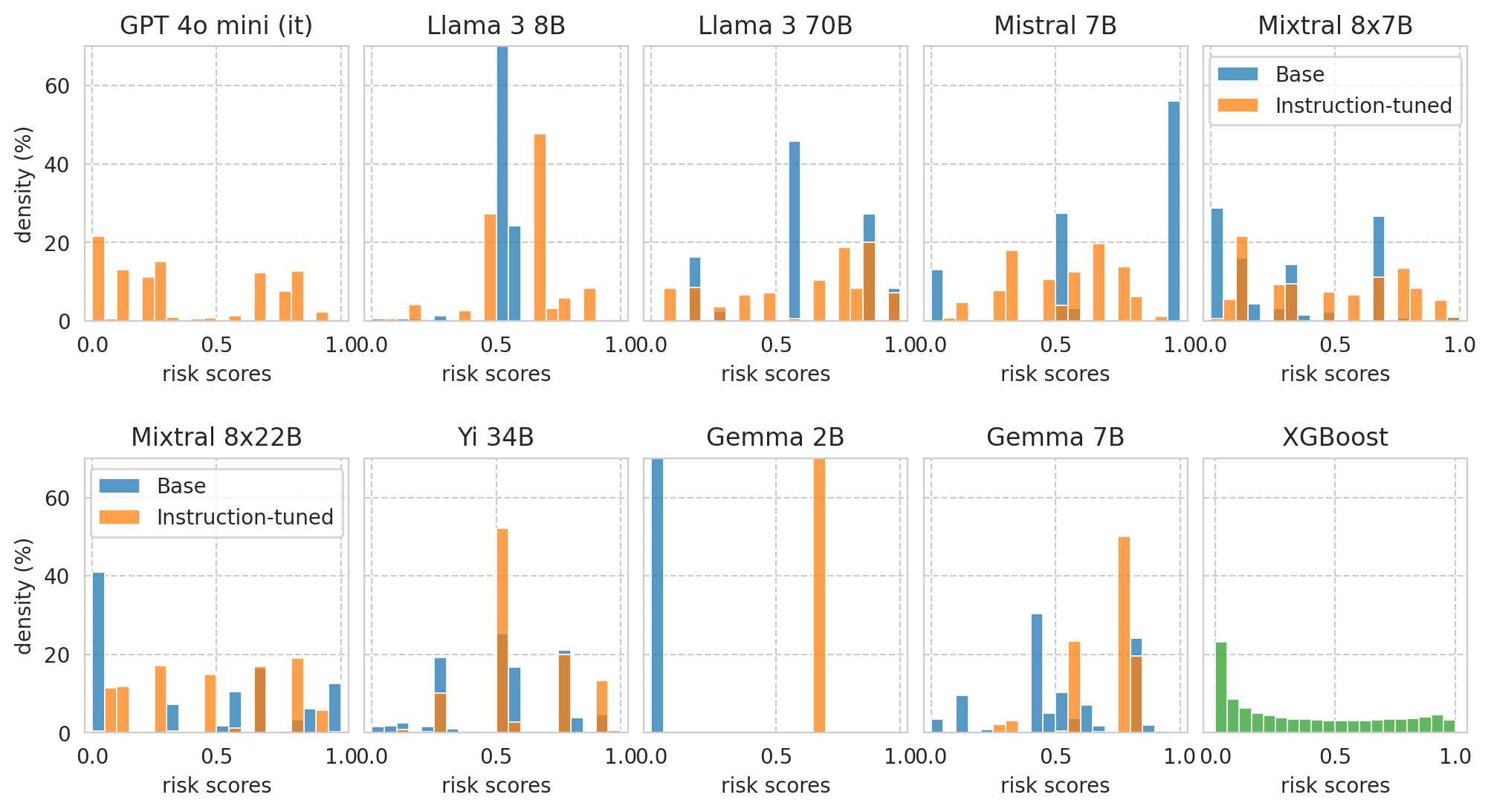
Calibration curves
Base models vs Instruction-tuned models:
[30]:
TASK = "ACSIncome"
# df = results_df[(results_df[task_col] == TASK) & (results_df[numeric_prompt_col] == NUMERIC_PROMPTING)]
df = all_results_df[(all_results_df[task_col] == TASK) & (all_results_df[numeric_prompt_col] == NUMERIC_PROMPTING)]
print(f"{len(df)=}")
len(df)=17
[31]:
from sklearn.calibration import CalibrationDisplay
from utils import prettify_model_name
base_models_to_plot = [m for m in df["base_name"].unique() if "gemma" not in m.lower()]
base_models_to_plot = [
"Meta-Llama-3-8B",
"Meta-Llama-3-70B",
"Mistral-7B-v0.1",
"Mixtral-8x7B-v0.1",
"Mixtral-8x22B-v0.1",
# "Yi-34B",
]
instr_models_to_plot = [
df[
(df["base_name"] == m)
& (df[model_col] != m)
][model_col].iloc[0]
for m in base_models_to_plot
]
# Add GPT models if any
instr_models_to_plot += [m[model_col] for _, m in df.iterrows() if "gpt" in m["name"].lower()]
fig, axes = plt.subplots(ncols=2, figsize=(8, 3), gridspec_kw=dict(wspace=0.33), sharey=False)
# Plot base models
for ax, model_list in zip(axes, (base_models_to_plot, instr_models_to_plot)):
for idx, m in enumerate(model_list):
curr_row = df[df[model_col] == m].iloc[0]
curr_scores = scores_df_map[curr_row.name]
disp = CalibrationDisplay.from_predictions(
y_true=curr_scores["label"],
y_prob=curr_scores["risk_score"],
n_bins=10,
strategy="quantile",
name=prettify_model_name(curr_row["base_name"]),
linestyle=["-.", ":", "--"][idx % 3],
ax=ax,
)
ax.set_xlim(0, 1)
ax.set_ylim(0, 1)
ylabel = "Fraction of positives " + r"$\left(\mathrm{P}[Y=1]\right)$"
axes[0].set_ylabel(ylabel)
axes[1].set_ylabel(ylabel)
xlabel = "Mean predicted probability" # + r" $(\mathbb{E}[R])$"
axes[0].set_xlabel(xlabel)
axes[1].set_xlabel(xlabel)
axes[0].set_title("Base models")
axes[1].set_title("Instruction-tuned models")
axes[0].legend().remove()
# Legent to the right of the right-most plot
h, l = axes[1].get_legend_handles_labels()
l[0] = "Perf. calibrated"
axes[1].legend(handles=h, labels=l, loc="upper left", bbox_to_anchor=(1.1, 1.1))
plt.plot()
save_fig(fig, f"calibration-curves-base-and-instr.pdf")
Saved figure to '../results/imgs/calibration-curves-base-and-instr.numeric-prompt.pdf'
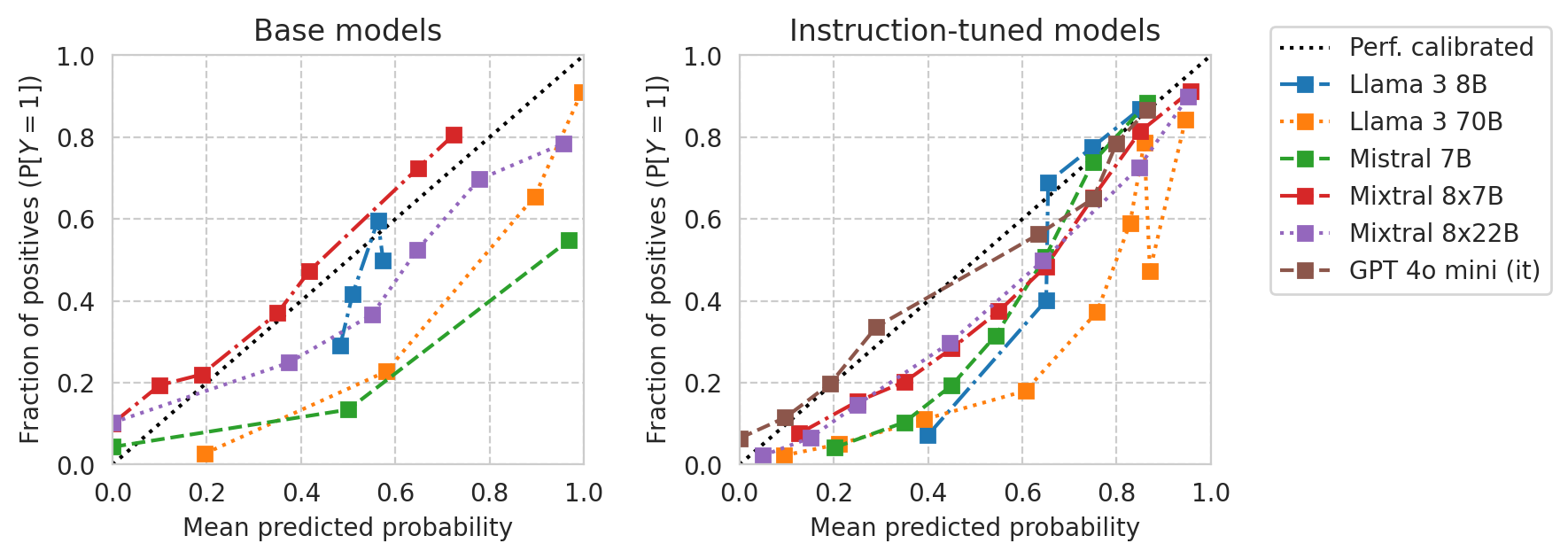
[32]:
from sklearn.calibration import CalibrationDisplay
from utils import prettify_model_name
base_models_to_plot = [m for m in df["base_name"].unique() if "gemma" not in m.lower()]
base_models_to_plot = [
"Meta-Llama-3-70B",
"Mixtral-8x7B-v0.1",
"Mixtral-8x22B-v0.1",
"Yi-34B",
]
instr_models_to_plot = [
df[
(df["base_name"] == m)
& (df[model_col] != m)
][model_col].iloc[0]
for m in base_models_to_plot
]
# Add GPT models if any
instr_models_to_plot += [m[model_col] for _, m in df.iterrows() if "gpt" in m["name"].lower()]
fig, axes = plt.subplots(ncols=2, figsize=(8, 3), gridspec_kw=dict(wspace=0.33), sharey=False)
# Plot base models
for ax, model_list in zip(axes, (base_models_to_plot, instr_models_to_plot)):
for idx, m in enumerate(model_list):
curr_row = df[df[model_col] == m].iloc[0]
curr_scores = scores_df_map[curr_row.name]
disp = CalibrationDisplay.from_predictions(
y_true=curr_scores["label"],
y_prob=curr_scores["risk_score"],
n_bins=10,
strategy="quantile",
name=prettify_model_name(curr_row["base_name"]),
linestyle=["-.", ":", "--"][idx % 3],
ax=ax,
)
ax.set_xlim(0, 1)
ax.set_ylim(0, 1)
ylabel = "Fraction of positives " + r"$\left(\mathrm{P}[Y=1]\right)$"
axes[0].set_ylabel(ylabel)
axes[1].set_ylabel(ylabel)
xlabel = "Mean predicted probability" # + r" $(\mathbb{E}[R])$"
axes[0].set_xlabel(xlabel)
axes[1].set_xlabel(xlabel)
axes[0].set_title("Base models")
axes[1].set_title("Instruction-tuned models")
axes[0].legend().remove()
# Legent to the right of the right-most plot
h, l = axes[1].get_legend_handles_labels()
l[0] = "Perf. calibrated"
axes[1].legend(handles=h, labels=l, loc="upper left", bbox_to_anchor=(1.1, 1.1))
plt.plot()
save_fig(fig, f"calibration-curves-base-and-instr.large-models.pdf")
Saved figure to '../results/imgs/calibration-curves-base-and-instr.large-models.numeric-prompt.pdf'
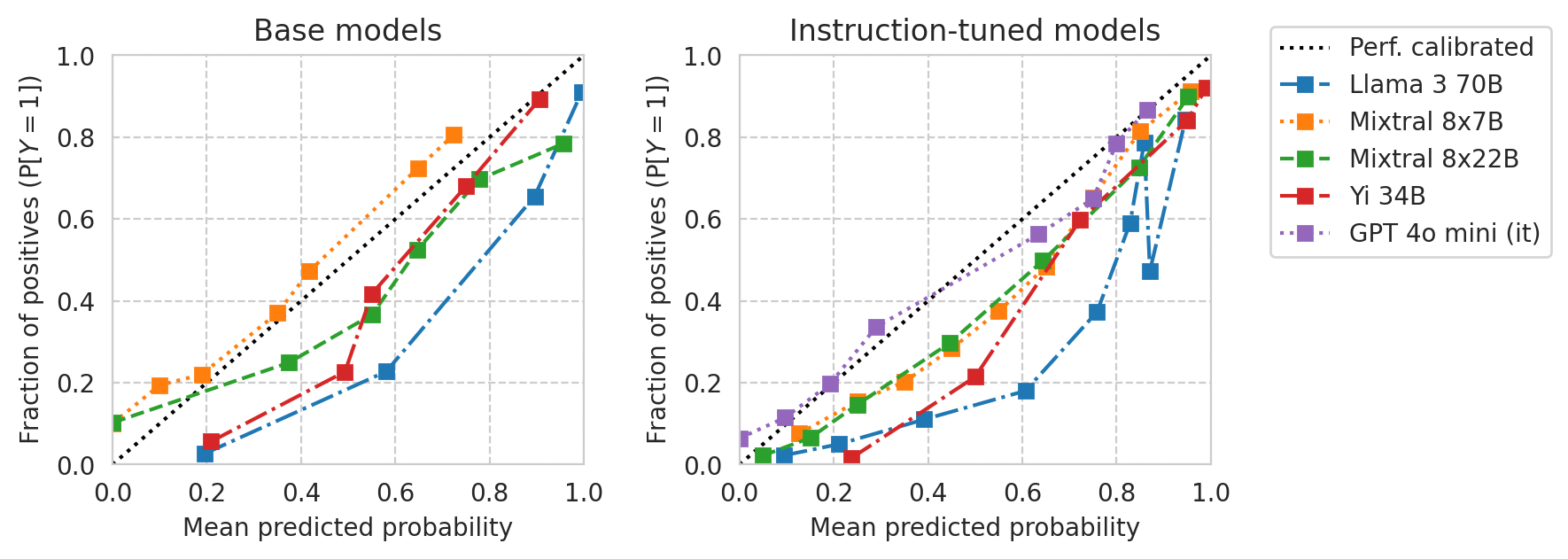
[33]:
from sklearn.calibration import CalibrationDisplay
from utils import prettify_model_name
base_models_to_plot = [m for m in df["base_name"].unique() if "gemma" not in m.lower()]
base_models_to_plot = [
"Meta-Llama-3-70B",
"Mixtral-8x7B-v0.1",
"Mixtral-8x22B-v0.1",
"Yi-34B",
]
instr_models_to_plot = [
df[
(df["base_name"] == m)
& (df[model_col] != m)
][model_col].iloc[0]
for m in base_models_to_plot
]
# Add GPT models if any
instr_models_to_plot += [m[model_col] for _, m in df.iterrows() if "gpt" in m["name"].lower()]
fig, axes = plt.subplots(ncols=2, figsize=(5, 2.2), gridspec_kw=dict(wspace=0.15), sharey=True)
# Plot base models
for ax, model_list in zip(axes, (base_models_to_plot, instr_models_to_plot)):
for idx, m in enumerate(model_list):
curr_row = df[df[model_col] == m].iloc[0]
curr_scores = scores_df_map[curr_row.name]
disp = CalibrationDisplay.from_predictions(
y_true=curr_scores["label"],
y_prob=curr_scores["risk_score"],
n_bins=10,
strategy="quantile",
name=prettify_model_name(curr_row["base_name"]),
linestyle=["-.", ":", "--"][idx % 3],
ax=ax,
ms=3.5,
)
ax.set_xlim(0, 1)
ax.set_ylim(0, 1)
ylabel = "Fraction of positives " + r"$\left(\mathrm{P}[Y=1]\right)$"
axes[0].set_ylabel(ylabel)
# axes[1].set_ylabel(ylabel)
axes[1].set_ylabel("")
# xlabel = "Mean predicted probability" # + r" $(\mathbb{E}[R])$"
xlabel = "Mean risk score"
axes[0].set_xlabel(xlabel)
axes[1].set_xlabel(xlabel)
axes[0].set_title("Base models")
axes[1].set_title("Instruction-tuned")
# Set prettier x ticks
xticks = (0, 0.25, 0.5, 0.75, 1)
xticks_labels = ("0.0", "0.25", "0.5", "0.75", "1.0")
axes[0].set_xticks(xticks, labels=xticks_labels)
axes[1].set_xticks(xticks, labels=xticks_labels)
axes[0].legend().remove()
# Legent to the right of the right-most plot
if NUMERIC_PROMPTING:
h, l = axes[1].get_legend_handles_labels()
l[0] = "Perf. calibrated"
axes[1].legend(handles=h, labels=l, loc="upper left", bbox_to_anchor=(1, 1))
else:
axes[1].legend().remove()
# Figure title
if NUMERIC_PROMPTING:
title = "Numeric Prompting"
else:
title = "Multiple-choice Prompting"
plt.suptitle(title, y=1.1, fontsize=14)
plt.plot()
save_fig(fig, f"calibration-curves-base-and-instr.large-models.smaller.pdf")
Saved figure to '../results/imgs/calibration-curves-base-and-instr.large-models.smaller.numeric-prompt.pdf'
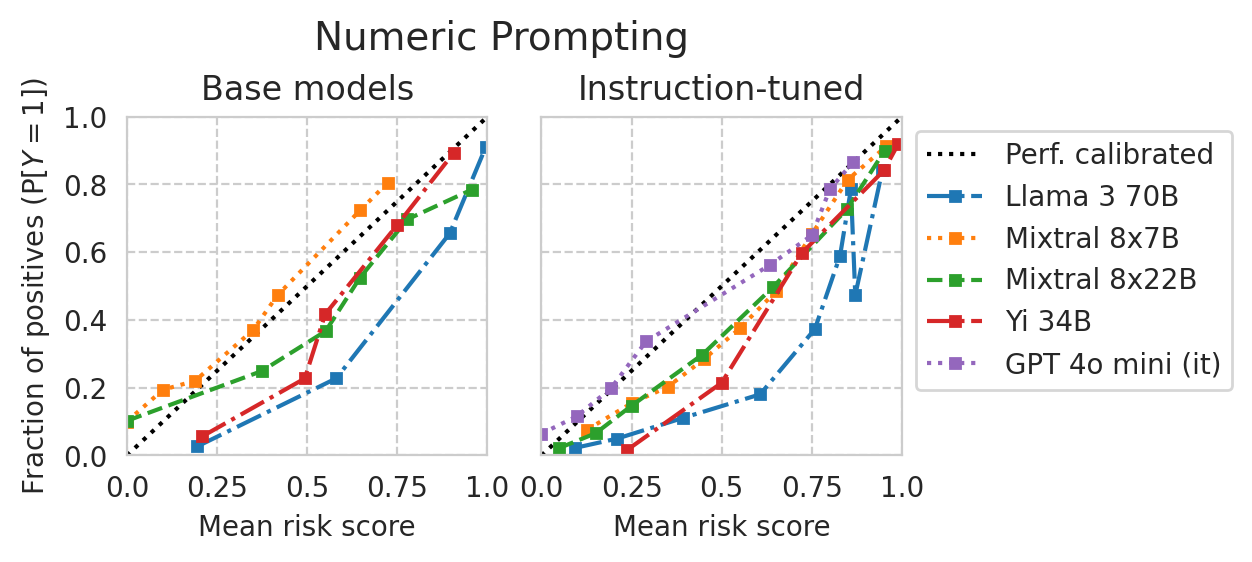
Calibration per sub-group
Plot calibration curves per race sub-group, for each model pair.
[34]:
%%time
acs_dataset = ACSDataset.make_from_task(task=TASK, cache_dir=DATA_DIR)
Loading ACS data...
CPU times: user 41.3 s, sys: 28.3 s, total: 1min 9s
Wall time: 1min 9s
Plot:
[35]:
# Omit small groups from the plots (results can be too noisy)
OMIT_GROUPS_BELOW_PCT = 4
N_BINS = 10
[36]:
sens_attr_col = "RAC1P"
sens_attr_map = {
1: "White",
2: "Black",
6: "Asian",
# 8: "Other", # some other race alone
}
name_to_sens_attr_map = {val: key for key, val in sens_attr_map.items()}
def plot_cali_curve(model_id, ax, df):
"""Plot sub-group calibration curves using sklearn"""
curr_row = df.loc[model_id]
curr_scores_df = scores_df_map[curr_row.name]
y_true = curr_scores_df["label"].to_numpy()
y_scores = curr_scores_df["risk_score"].to_numpy()
sens_attr = acs_dataset.data.loc[curr_scores_df.index][sens_attr_col].to_numpy()
for idx, group_val in enumerate(np.unique(sens_attr)):
group_filter = sens_attr == group_val
if np.sum(group_filter) < len(group_filter) * 0.01 * OMIT_GROUPS_BELOW_PCT:
# print(f"Skipping group={group_val}")
continue
disp = CalibrationDisplay.from_predictions(
y_true=y_true[group_filter],
y_prob=y_scores[group_filter],
n_bins=N_BINS,
# strategy="uniform",
strategy="quantile",
name=str(sens_attr_map.get(group_val, group_val)),
linestyle=["-.", ":", "--"][idx % 3],
ax=ax,
)
# Set other plot settings
ax.set_title(curr_row["name"])
return disp
[37]:
from folktexts.evaluation import bootstrap_estimate
def plot_cali_curve_ci(model_id, ax, df, ci=95):
"""Plot sub-group calibration curves with bootstrap confidence intervals"""
curr_row = df.loc[model_id]
curr_scores_df = scores_df_map[curr_row.name]
y_true = curr_scores_df["label"].to_numpy()
y_scores = curr_scores_df["risk_score"].to_numpy()
sens_attr = acs_dataset.data.loc[curr_scores_df.index][sens_attr_col].to_numpy()
# Compute bins
if len(np.unique(y_scores)) == 1:
ax.set_title(curr_row["name"])
return
y_scores_binned, bin_edges = pd.qcut(y_scores, q=N_BINS, retbins=True, duplicates="drop")
bin_names = y_scores_binned.categories # Name used for each bin: "(bin_low_range, bin_high_range)"
# To hold plot render artifacts
plot_artifacts = {}
for idx, group_val in enumerate(np.unique(sens_attr)):
group_filter = sens_attr == group_val
if (
np.sum(group_filter) < len(group_filter) * 0.01 * OMIT_GROUPS_BELOW_PCT
or group_val not in sens_attr_map.keys()
):
# print(f"Skipping group={group_val}")
continue
group_labels = y_true[group_filter]
group_scores = y_scores[group_filter]
group_cali_points = []
for b in bin_names:
bin_filter = y_scores_binned == b
group_labels_current_bin = y_true[group_filter & bin_filter]
group_scores_current_bin = y_scores[group_filter & bin_filter]
results = bootstrap_estimate(
eval_func=lambda labels, scores, sensattr: {
"mean_score": np.mean(scores),
"mean_label": np.mean(labels),
},
y_true=group_labels_current_bin,
y_pred_scores=group_scores_current_bin,
sensitive_attribute=None,
)
# Store plot point for this bin
group_cali_points.append((
results["mean_score_mean"], # x coordinate
results["mean_label_mean"], # y coordinate
( # y coordinate c.i. range
results["mean_label_low-percentile"],
results["mean_label_high-percentile"],
),
))
# Get group label from sensitive attribute map
group_label = str(sens_attr_map.get(group_val, group_val))
# Plot this group's calibration curve w/ conf. intervals!
line, caps, bars = ax.errorbar(
# x=[mean_score for mean_score, *_ in group_cali_points],
x=[(bin_edges[idx-1] + bin_edges[idx]) / 2. for idx in range(1, len(bin_edges))],
y=[mean_label for _, mean_label, _ in group_cali_points],
yerr=np.hstack(
[
np.abs(np.array(yerr_range).reshape(2, 1) - y)
for _x, y, yerr_range in group_cali_points]
),
fmt="o", markersize=1,
linestyle=["-.", "-", "--"][idx % 3],
linewidth=2,
label=group_label,
)
plot_artifacts[group_label] = (line, caps, bars)
# Global plot settings
ax.plot(
[0,1], [0,1],
ls="dotted", color="black",
)
# Draw custom legend
handles = []
for group, (l, c, b) in plot_artifacts.items():
l.set_label(group)
l.set_markersize(0)
handles.append(l)
# Perfectly calibrated line
perf_cal_line = plt.Line2D([], [], ls=":", color="black", label="Perf. calibrated")
# Confidence interv. marker line
conf_int_line = plt.Line2D([], [], lw=0, ms=10, marker="|", markeredgewidth=2, color="grey", label="$95\%$ conf. int.")
ax.legend(handles=handles + [conf_int_line, perf_cal_line])
ax.set_title(curr_row["name"])
return disp
[38]:
from sklearn.calibration import CalibrationDisplay
# Get results for the current task
task_df = all_results_df[all_results_df[task_col] == TASK]
# Get all base/instruct model pairs
base_models_to_plot = [
"Meta-Llama-3-8B",
"Meta-Llama-3-70B",
"Mistral-7B-v0.1",
"Mixtral-8x7B-v0.1",
"Mixtral-8x22B-v0.1",
"Yi-34B",
]
# NOTE: Gemma models have degenerate distributions that always predict the same score, can't plot calibration properly...
instr_models_to_plot = [
df[
(df["base_name"] == m)
& (df[model_col] != m)
][model_col].iloc[0]
for m in base_models_to_plot
]
# Add GPT models if any
instr_models_to_plot += [m[model_col] for _, m in df.iterrows() if "gpt" in m["name"].lower()]
base_models_to_plot += [None for _ in range(len(instr_models_to_plot) - len(base_models_to_plot))]
base_it_pairs = list(zip(base_models_to_plot, instr_models_to_plot))
for base_model, it_model in tqdm(base_it_pairs):
fig, axes = plt.subplots(ncols=2, figsize=(7, 2.8), gridspec_kw=dict(wspace=0.35), sharey=False)
for idx, ax, m in zip(range(len(axes)), axes, (base_model, it_model)):
if m is None:
ax.remove()
continue
curr_row = task_df[(task_df[model_col] == m) & (task_df["uses_all_features"])].iloc[0]
curr_id = curr_row.name
# # Original sklearn calibration plot:
# plot_cali_curve(curr_id, ax=ax, df=task_df)
# # Plot with confidence intervals:
plot_cali_curve_ci(curr_id, ax=ax, df=task_df)
# Remove left plot legend
if idx == 0:
ax.get_legend().remove()
else:
ax.get_legend().set(loc="upper left", bbox_to_anchor=(1.1, 1))
ax.set_xlim(0, 1)
ax.set_ylim(0, 1)
ax.set_xlabel("Mean risk score")
ax.set_ylabel("Fraction of positives")
plt.plot()
save_fig(fig, f"calibration-curves-per-subgroup.{base_model}.pdf")
Saved figure to '../results/imgs/calibration-curves-per-subgroup.Meta-Llama-3-8B.numeric-prompt.pdf'
Saved figure to '../results/imgs/calibration-curves-per-subgroup.Meta-Llama-3-70B.numeric-prompt.pdf'
Saved figure to '../results/imgs/calibration-curves-per-subgroup.Mistral-7B-v0.1.numeric-prompt.pdf'
Saved figure to '../results/imgs/calibration-curves-per-subgroup.Mixtral-8x7B-v0.1.numeric-prompt.pdf'
Saved figure to '../results/imgs/calibration-curves-per-subgroup.Mixtral-8x22B-v0.1.numeric-prompt.pdf'
Saved figure to '../results/imgs/calibration-curves-per-subgroup.Yi-34B.numeric-prompt.pdf'
Saved figure to '../results/imgs/calibration-curves-per-subgroup.None.numeric-prompt.pdf'
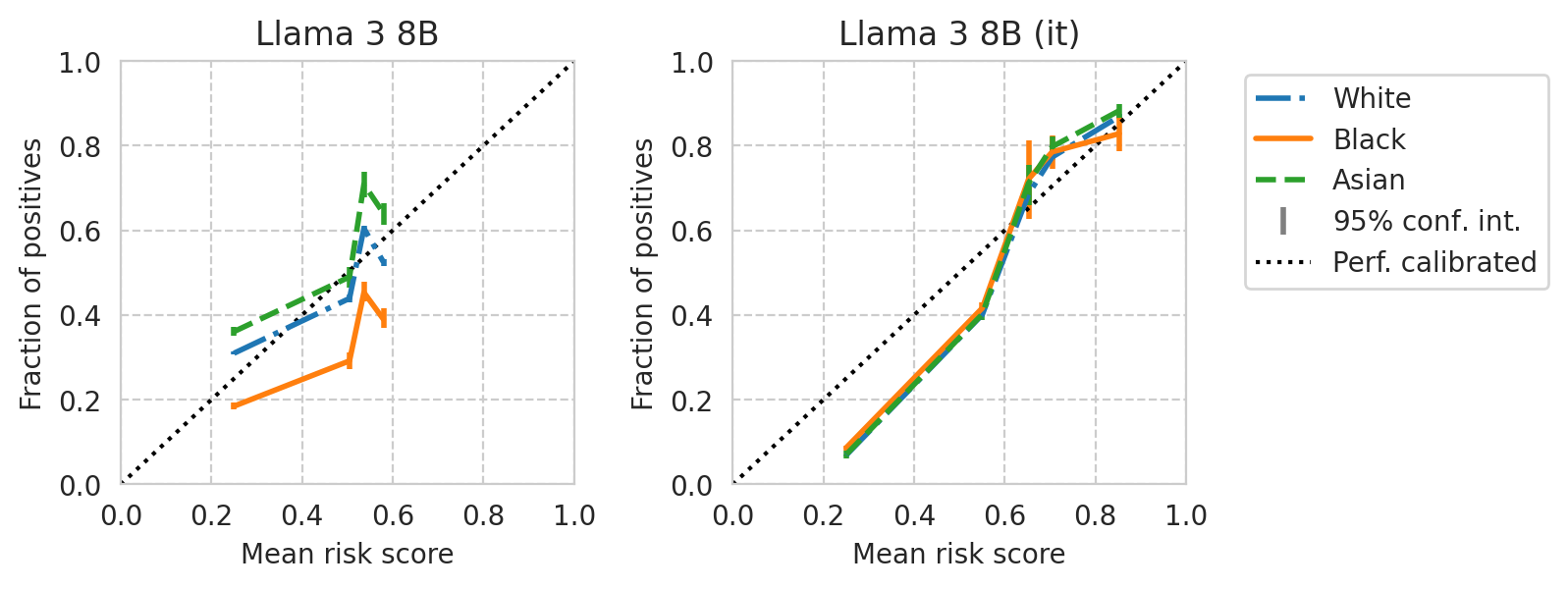
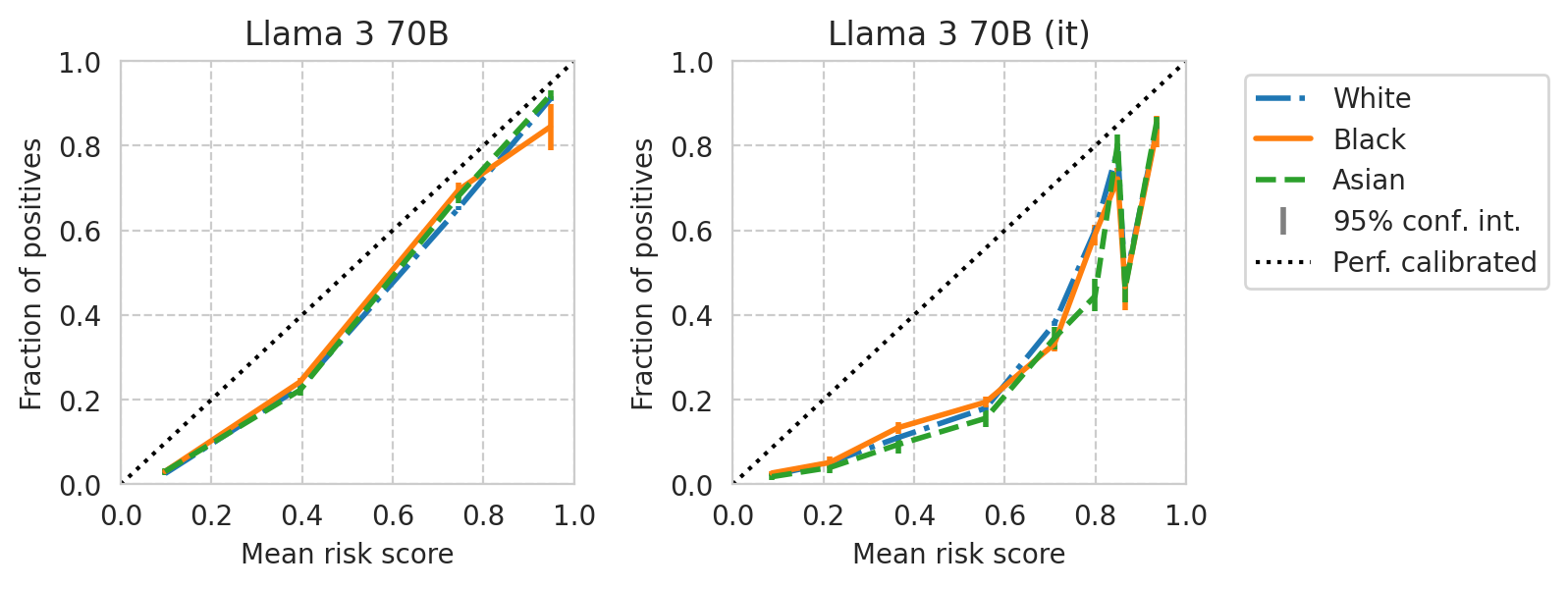
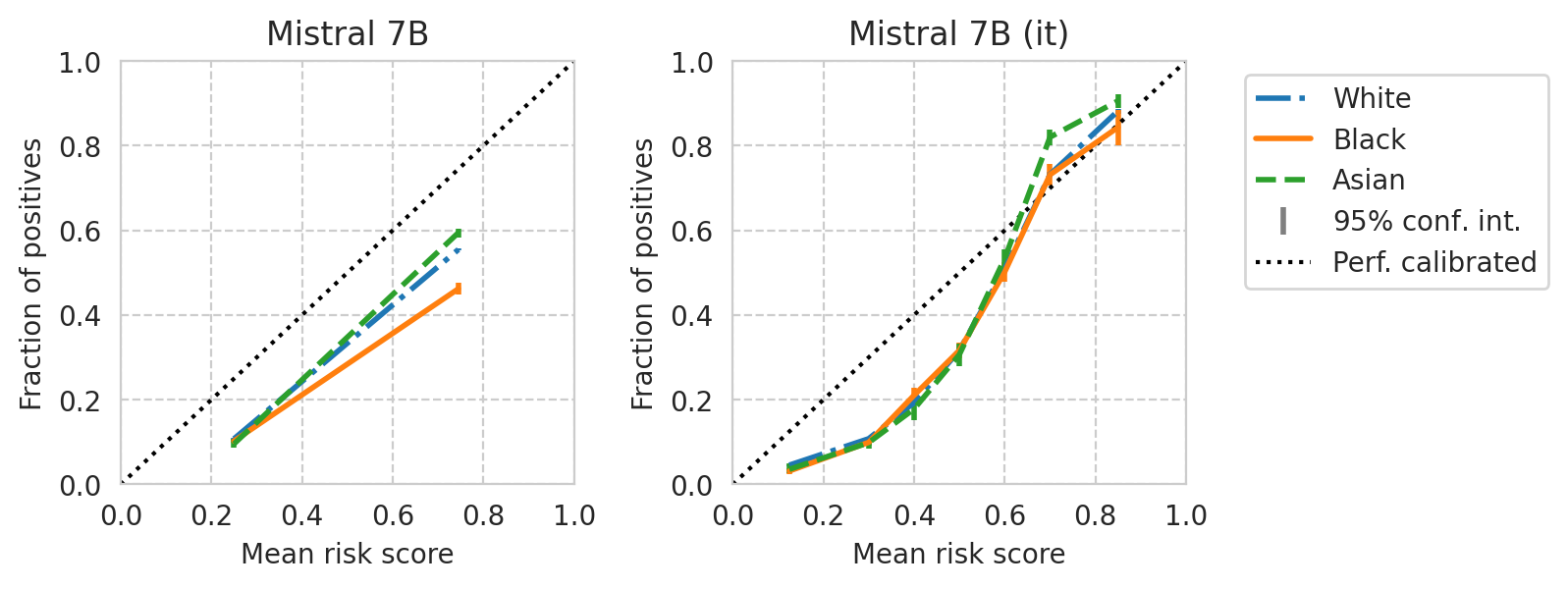
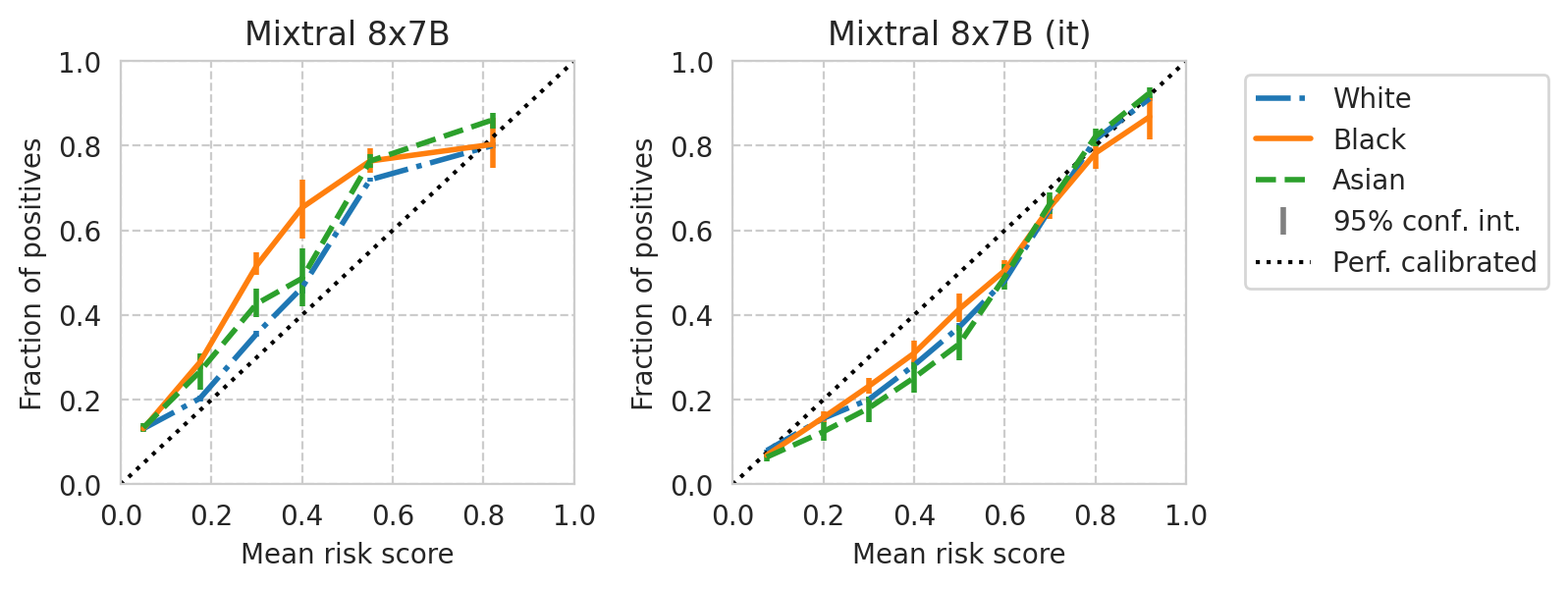
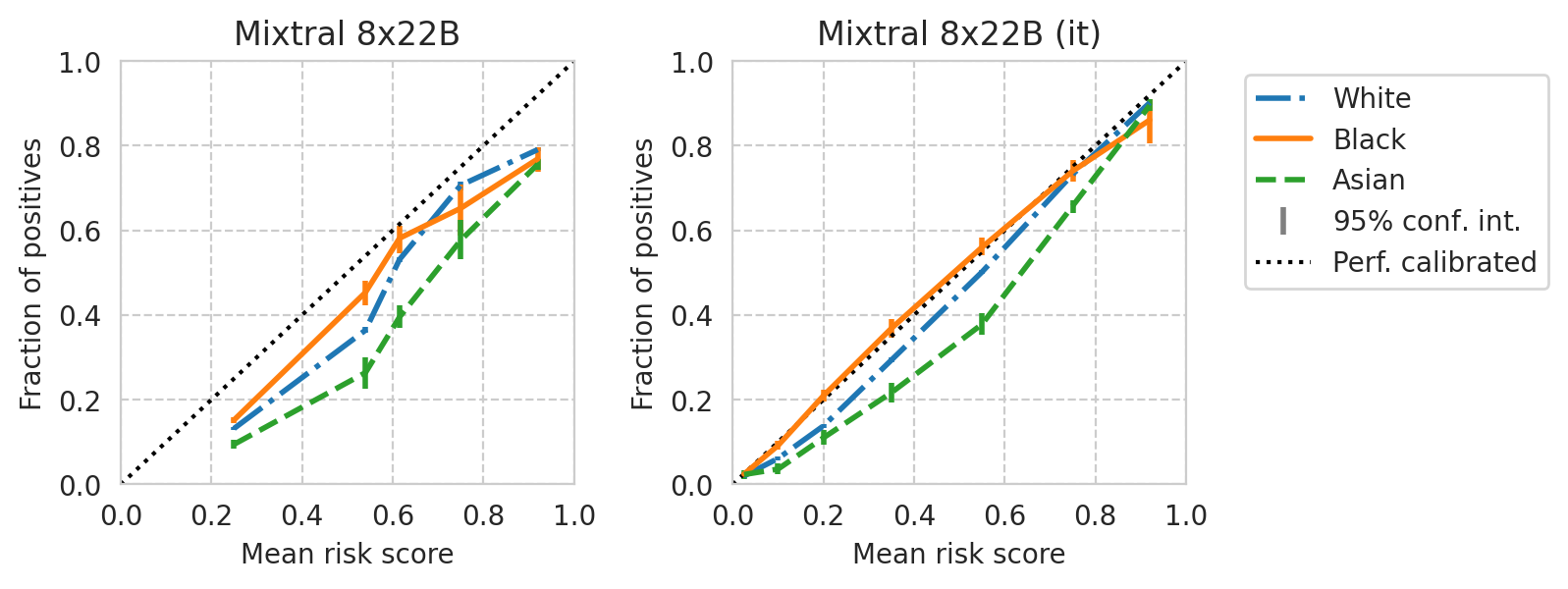
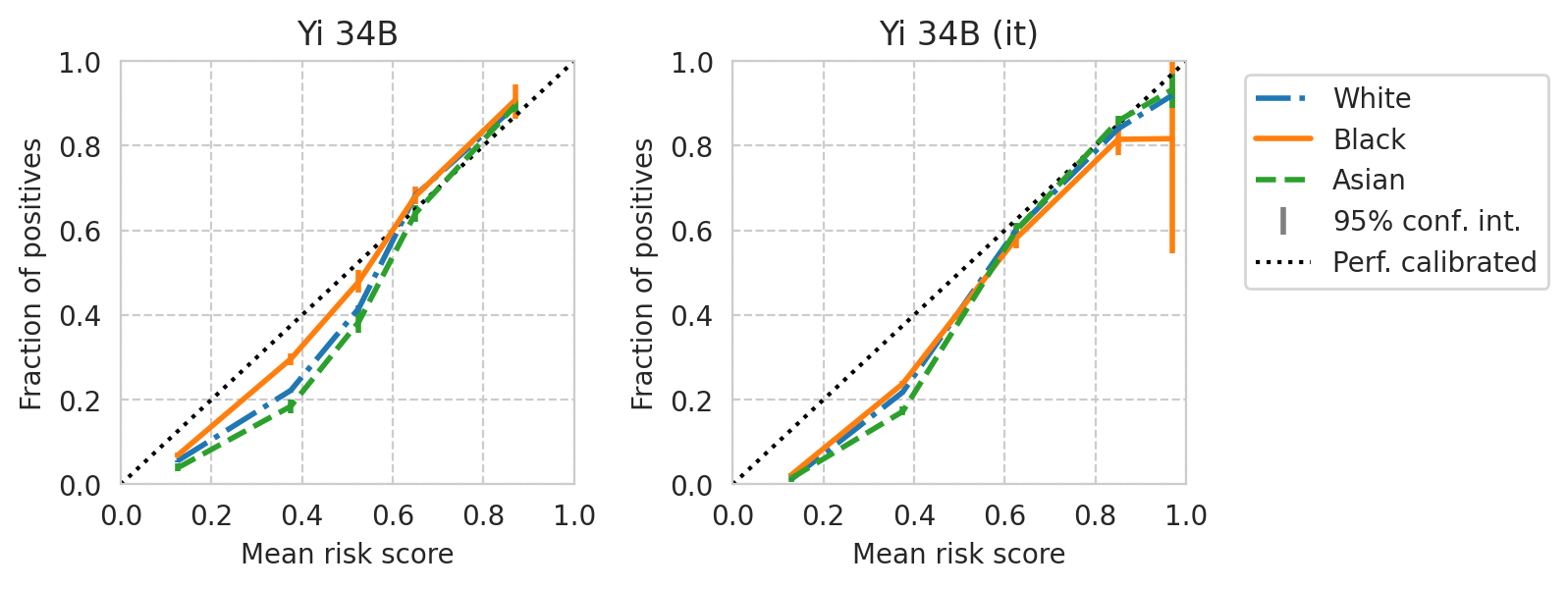
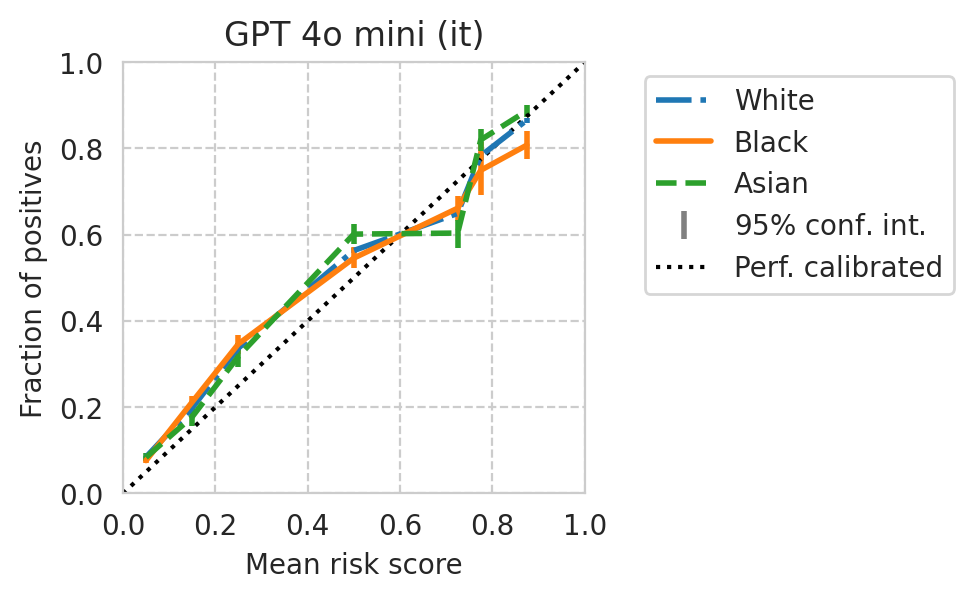
[39]:
from sklearn.calibration import CalibrationDisplay
# Get results for the current task
task_df = all_results_df[all_results_df[task_col] == TASK]
# Get all base/instruct model pairs
base_models_to_plot = [
"Meta-Llama-3-8B",
"Meta-Llama-3-70B",
"Mistral-7B-v0.1",
"Mixtral-8x7B-v0.1",
"Mixtral-8x22B-v0.1",
"Yi-34B",
]
# NOTE: Gemma models have degenerate distributions that always predict the same score, can't plot calibration properly...
instr_models_to_plot = [
df[
(df["base_name"] == m)
& (df[model_col] != m)
][model_col].iloc[0]
for m in base_models_to_plot
]
# Add GPT models if any
instr_models_to_plot += [m[model_col] for _, m in df.iterrows() if "gpt" in m["name"].lower()]
base_models_to_plot += [None for _ in range(len(instr_models_to_plot) - len(base_models_to_plot))]
base_it_pairs = list(zip(base_models_to_plot, instr_models_to_plot))
for base_model, it_model in tqdm(base_it_pairs):
fig, axes = plt.subplots(ncols=2, figsize=(4.8, 2.2), gridspec_kw=dict(wspace=0.15), sharey=True)
for idx, ax, m in zip(range(len(axes)), axes, (base_model, it_model)):
if m is None:
ax.remove()
continue
curr_row = task_df[(task_df[model_col] == m) & (task_df["uses_all_features"])].iloc[0]
curr_id = curr_row.name
# # Original sklearn calibration plot:
# plot_cali_curve(curr_id, ax=ax, df=task_df)
# # Plot with confidence intervals:
plot_cali_curve_ci(curr_id, ax=ax, df=task_df)
ax.set_xlim(0, 1)
ax.set_ylim(0, 1)
ax.set_xlabel("Mean risk score")
if idx == 0:
ax.set_ylabel("Fraction of positives")
# Set prettier x-ticks
xticks = (0, 0.25, 0.5, 0.75, 1)
xticks_labels = ("0.0", "0.25", "0.5", "0.75", "1.0")
ax.set_xticks(xticks, labels=xticks_labels)
# Prepare legend
axes[0].legend().remove()
if NUMERIC_PROMPTING:
axes[1].get_legend().set(loc="upper left", bbox_to_anchor=(1.03, 1))
else:
axes[1].legend().remove()
# Figure title
if NUMERIC_PROMPTING:
title = "Numeric Prompting"
else:
title = "Multiple-choice Prompting"
# Don't use suptitle for GPT4 (no base model)
if base_model is not None:
plt.suptitle(title, y=1.1, fontsize=14)
else:
model_title = axes[1].get_title()
plt.title(f"{title}\n{model_title}")
plt.plot()
save_fig(fig, f"calibration-curves-per-subgroup.{base_model}.smaller.pdf")
Saved figure to '../results/imgs/calibration-curves-per-subgroup.Meta-Llama-3-8B.smaller.numeric-prompt.pdf'
Saved figure to '../results/imgs/calibration-curves-per-subgroup.Meta-Llama-3-70B.smaller.numeric-prompt.pdf'
Saved figure to '../results/imgs/calibration-curves-per-subgroup.Mistral-7B-v0.1.smaller.numeric-prompt.pdf'
Saved figure to '../results/imgs/calibration-curves-per-subgroup.Mixtral-8x7B-v0.1.smaller.numeric-prompt.pdf'
Saved figure to '../results/imgs/calibration-curves-per-subgroup.Mixtral-8x22B-v0.1.smaller.numeric-prompt.pdf'
Saved figure to '../results/imgs/calibration-curves-per-subgroup.Yi-34B.smaller.numeric-prompt.pdf'
WARNING:matplotlib.legend:No artists with labels found to put in legend. Note that artists whose label start with an underscore are ignored when legend() is called with no argument.
Saved figure to '../results/imgs/calibration-curves-per-subgroup.None.smaller.numeric-prompt.pdf'
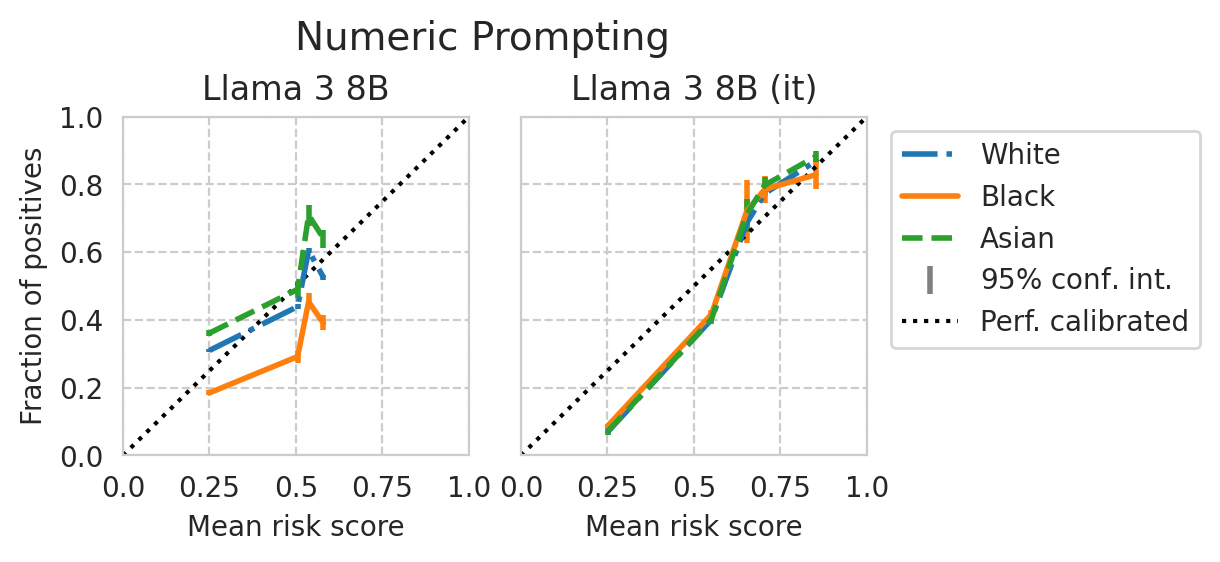
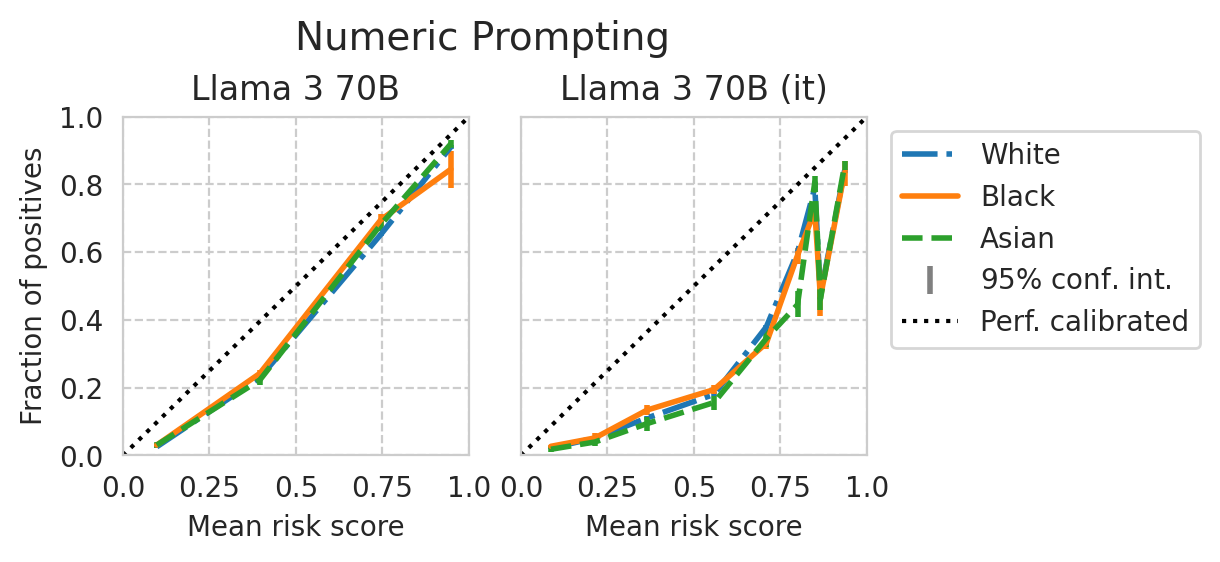
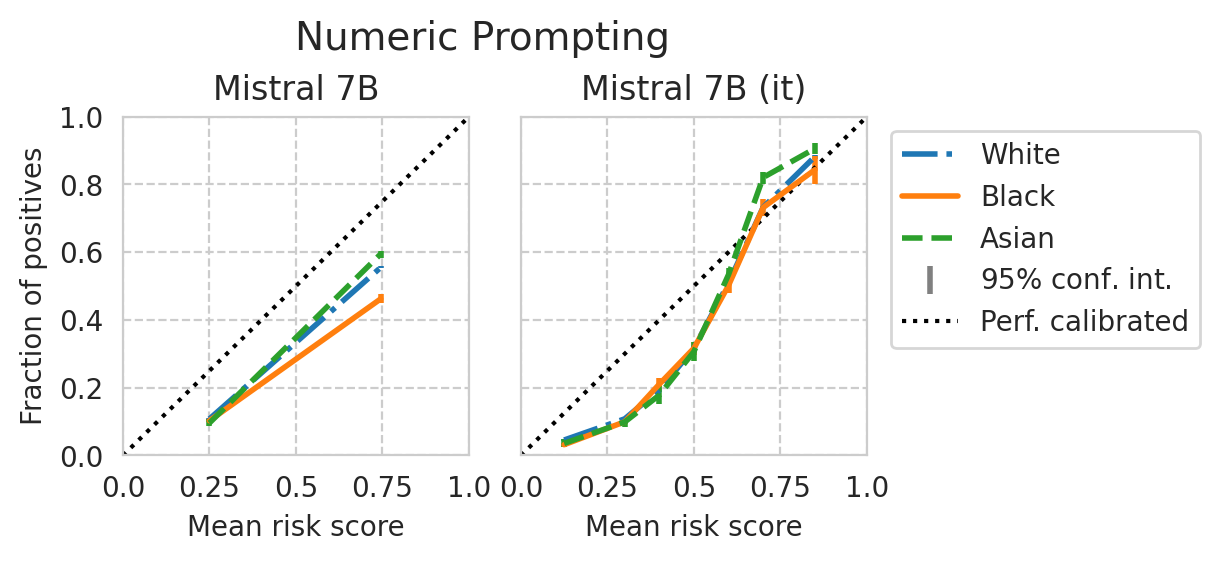
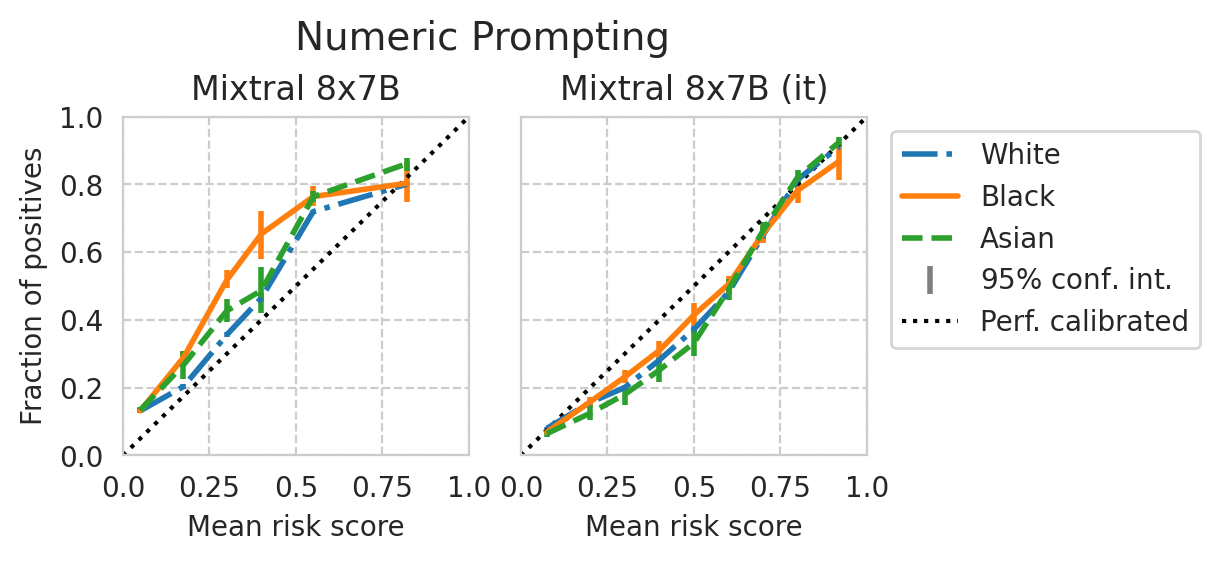
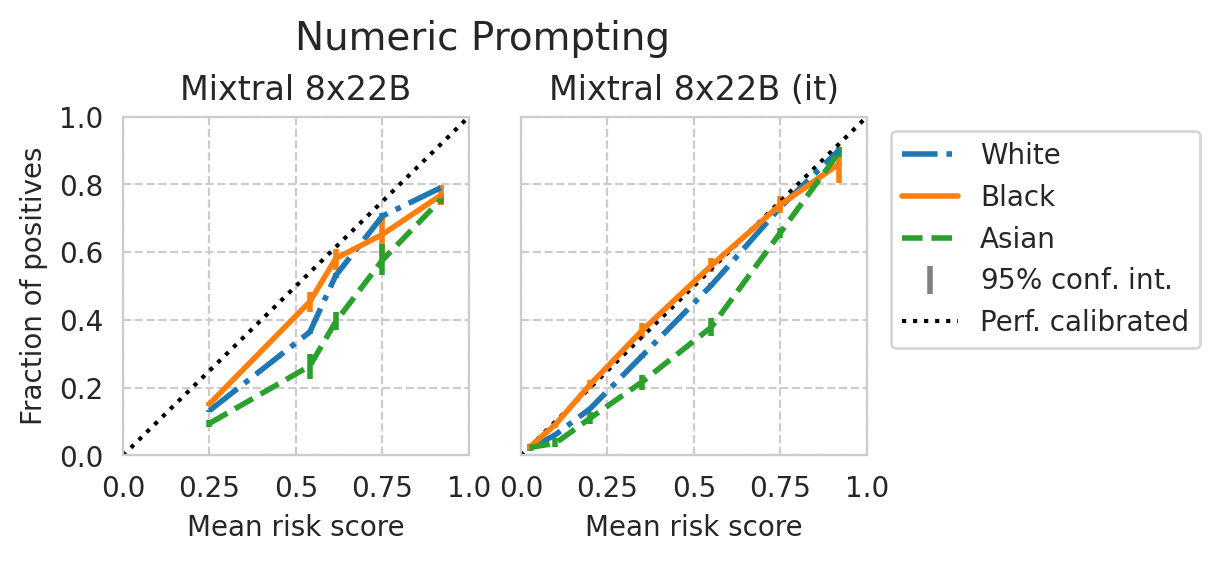
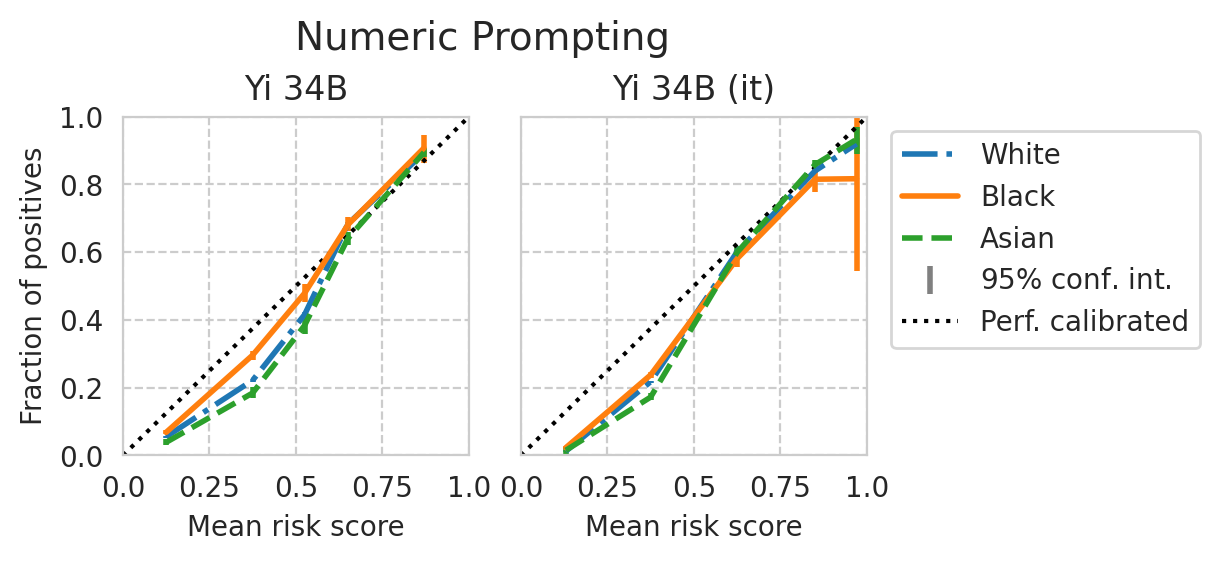
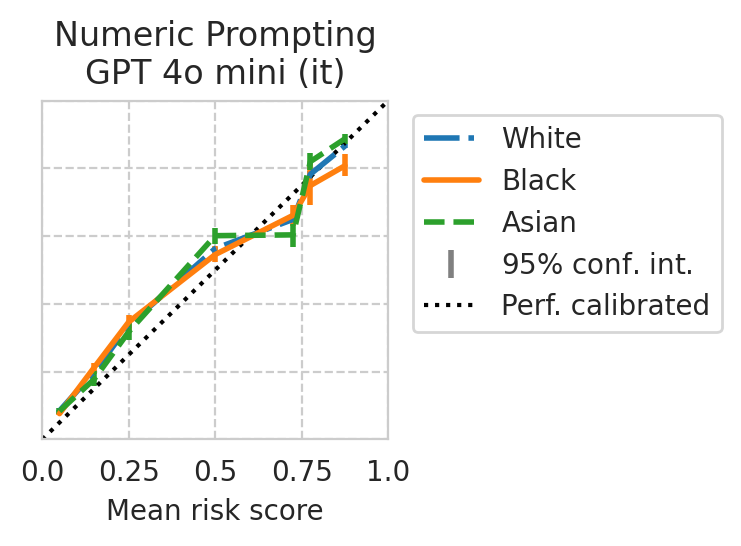
Score distribution per sub-group
[40]:
sens_attr_data = acs_dataset.data[sens_attr_col]
sens_attr_data.head(3)
[40]:
1 2
2 1
8 1
Name: RAC1P, dtype: int64
[41]:
# Plot settings
plot_config = dict(
bins=20,
binrange=(0, 1),
stat="percent",
)
for base_model, it_model in tqdm(base_it_pairs):
fig, axes = plt.subplots(ncols=2, figsize=(8, 3), gridspec_kw=dict(wspace=0.33), sharey=False)
for idx, ax, m in zip(range(len(axes)), axes, (base_model, it_model)):
if m is None:
ax.remove()
continue
model_row = task_df[(task_df[model_col] == m) & (task_df["uses_all_features"])].iloc[0]
model_id = model_row.name
scores_df = scores_df_map[model_id]
scores_df["group"] = sens_attr_data.loc[scores_df.index]
# sns.histplot(
# data=scores_df,
# x="risk_score",
# hue="group",
# ax=ax,
# **plot_config,
# )
for group_val, group_name in sens_attr_map.items():
group_scores_df = scores_df[sens_attr_data.loc[scores_df.index] == group_val]
sns.histplot(
group_scores_df["risk_score"],
label=group_name,
ax=ax,
alpha=0.5,
**plot_config,
)
# Remove left plot legend
if idx == 0:
ax.legend(loc="upper left")
ax.set_xlim(0, 1)
# ax.set_ylim(0, 1)
ax.set_title(model_row["name"])
plt.plot()
save_fig(fig, f"score-per-subgroup.{base_model}.pdf")
Saved figure to '../results/imgs/score-per-subgroup.Meta-Llama-3-8B.numeric-prompt.pdf'
Saved figure to '../results/imgs/score-per-subgroup.Meta-Llama-3-70B.numeric-prompt.pdf'
Saved figure to '../results/imgs/score-per-subgroup.Mistral-7B-v0.1.numeric-prompt.pdf'
Saved figure to '../results/imgs/score-per-subgroup.Mixtral-8x7B-v0.1.numeric-prompt.pdf'
Saved figure to '../results/imgs/score-per-subgroup.Mixtral-8x22B-v0.1.numeric-prompt.pdf'
Saved figure to '../results/imgs/score-per-subgroup.Yi-34B.numeric-prompt.pdf'
Saved figure to '../results/imgs/score-per-subgroup.None.numeric-prompt.pdf'
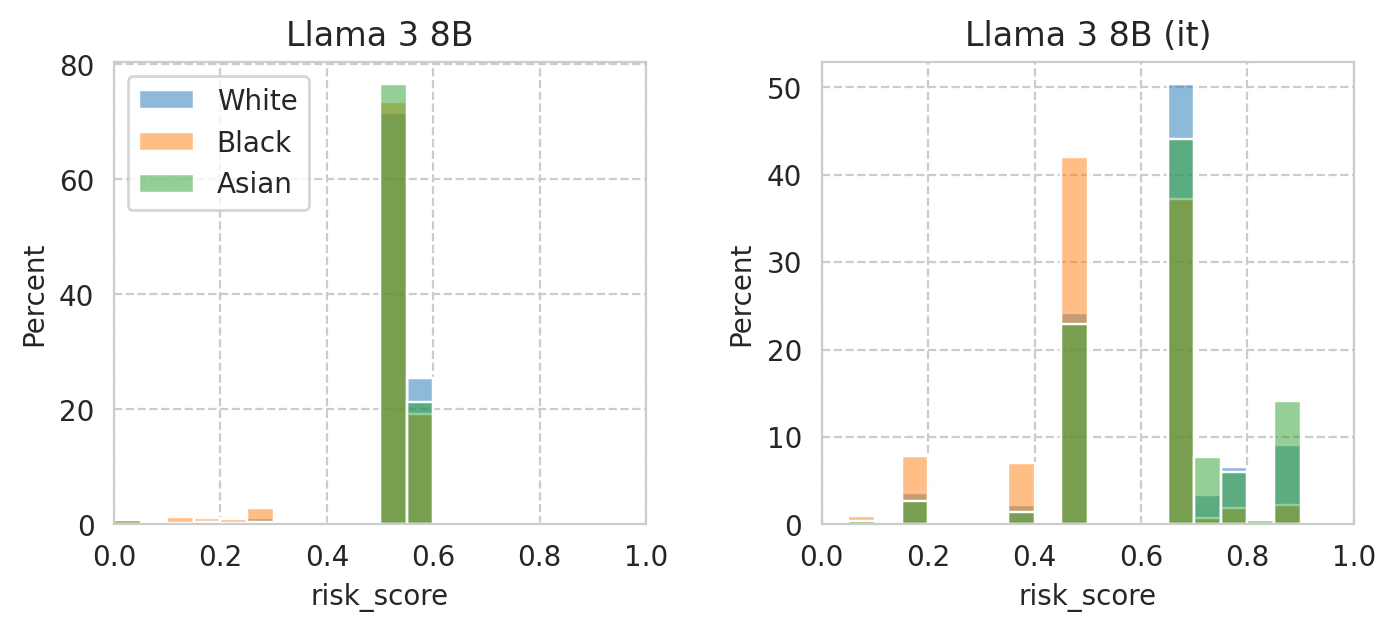
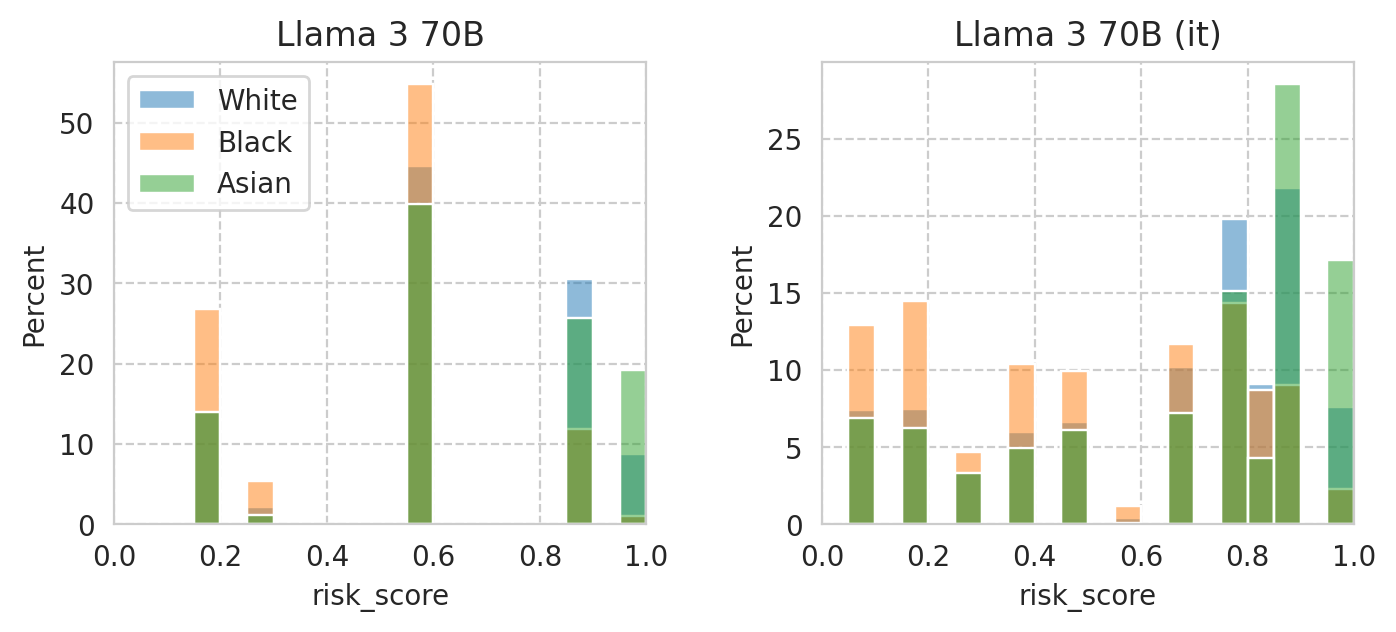
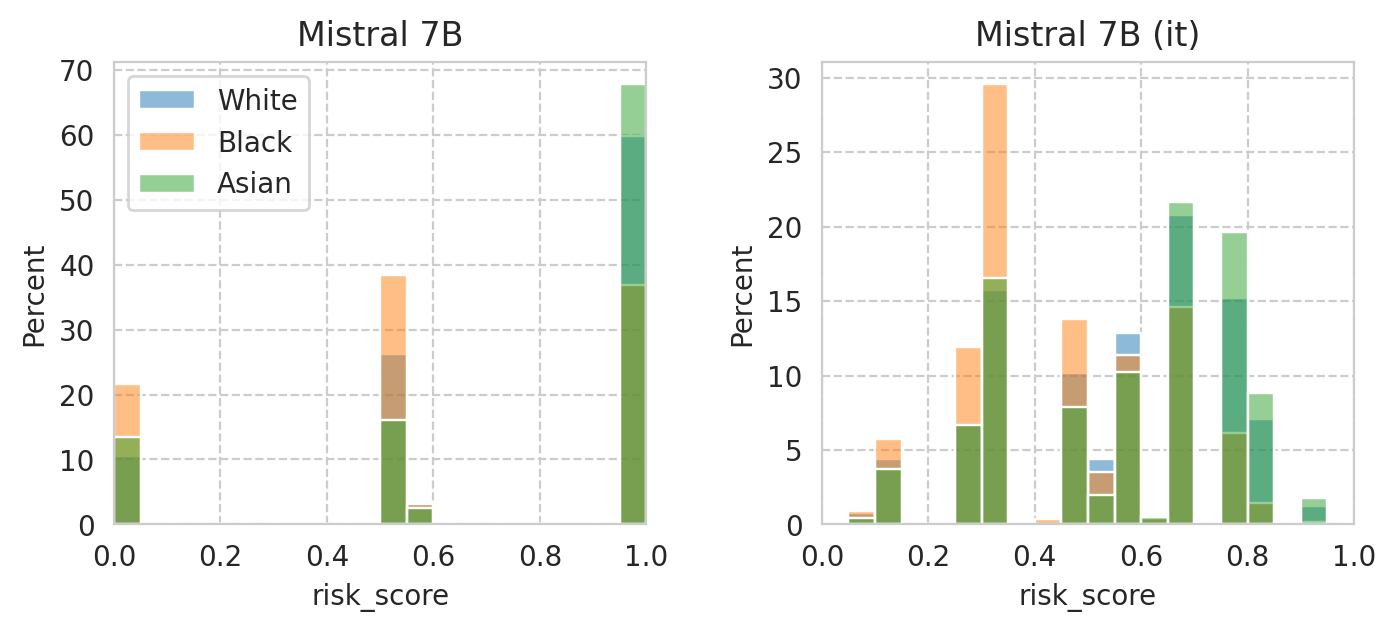
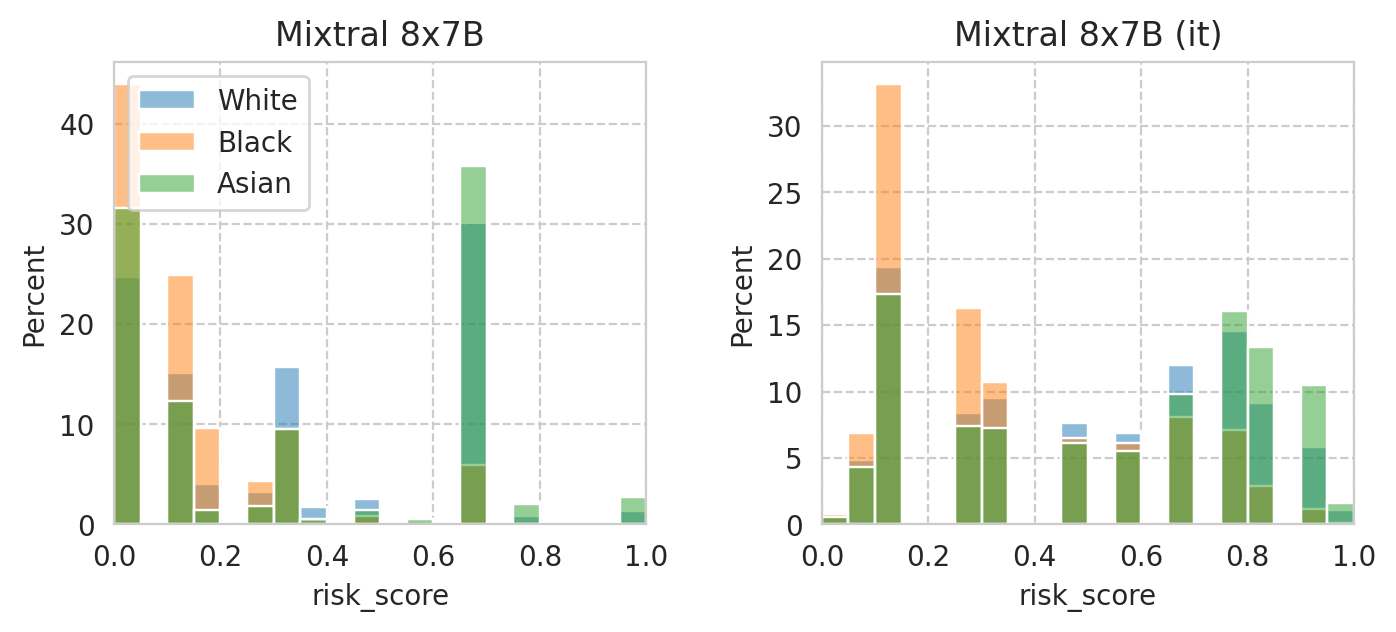
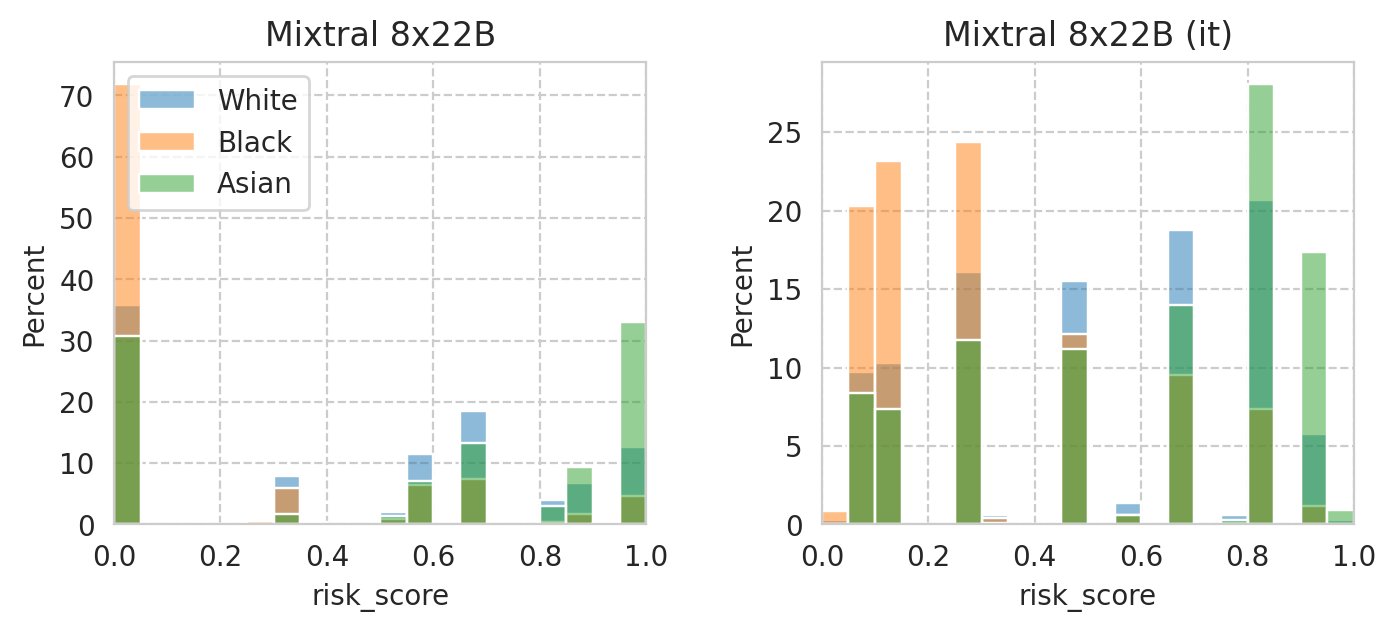
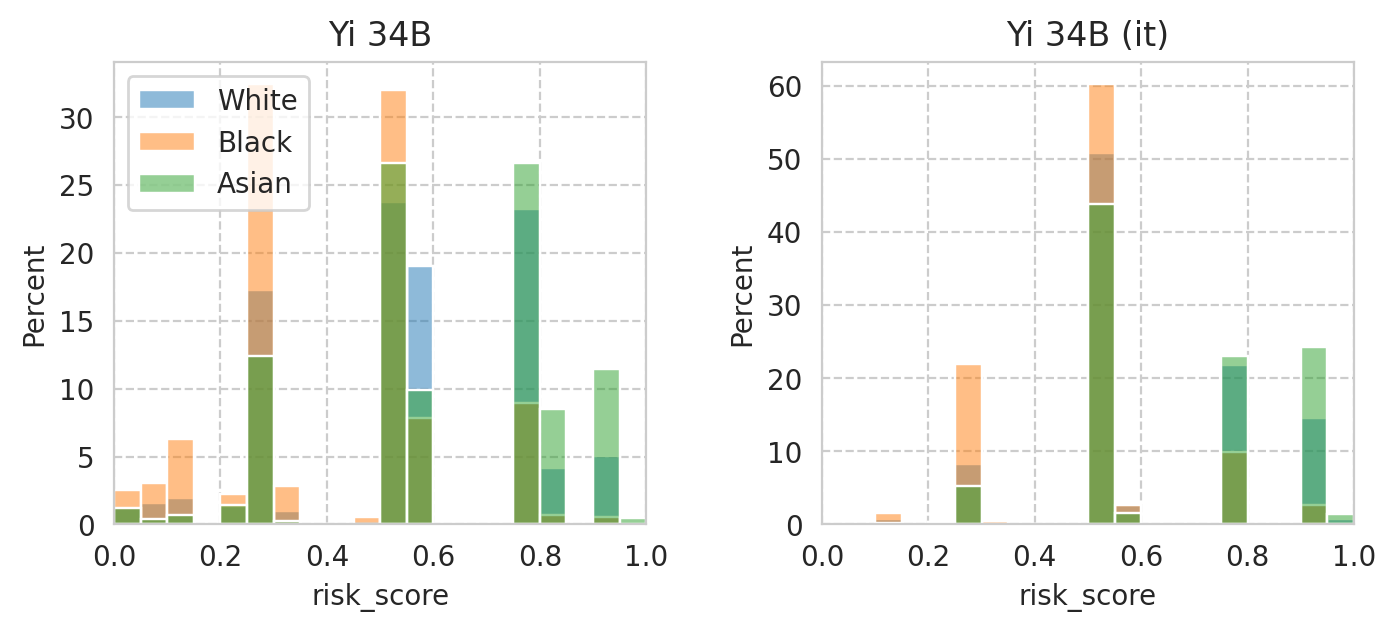
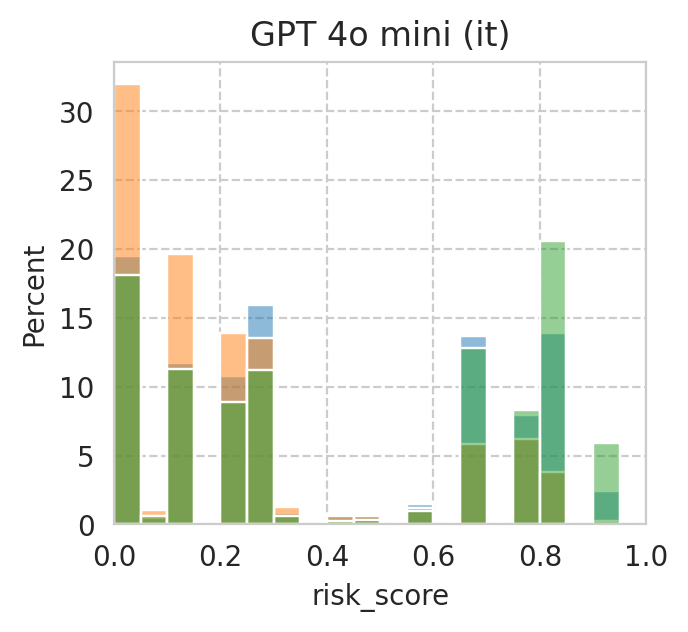
Compute mean under-/over-estimation of risk score
It’s basocally akin to computing ECE without the absolute…
[42]:
def compute_confidence_bias_metric_helper(data):
"""Helper to compute the under- / over-confidence metric.
"""
mean_label = data["label"].mean()
mean_score = data["risk_score"].mean()
if mean_score < 0.5:
return ((1 - mean_score) - (1 - mean_label))
else:
return (mean_score - mean_label)
def compute_confidence_bias_metric(model_id, quantiled_bins=False, scores_df=None):
if scores_df is None:
scores_df = scores_df_map[model_id]
discretization_func = pd.qcut if quantiled_bins else pd.cut
scores_df["score_bin"] = discretization_func(scores_df["risk_score"], 10, labels=range(10))
bias_metric_val = (1 / len(scores_df)) * sum(
len(bin_data) * compute_confidence_bias_metric_helper(bin_data)
for bin_ in range(10)
if len(bin_data := scores_df[scores_df["score_bin"] == bin_]) > 0
)
return float(bias_metric_val)
[43]:
confidence_scores = {
m: compute_confidence_bias_metric(m)
for m in tqdm(scores_df_map.keys())
}
[44]:
all_results_df["under_over_score"] = all_results_df.apply(lambda row: confidence_scores[row.name], axis=1)
all_results_df.sort_values("under_over_score", ascending=True)["under_over_score"]
[44]:
Meta-Llama-3-8B-Instruct__ACSPublicCoverage__-1__Num -0.161384
Mixtral-8x7B-Instruct-v0.1__ACSPublicCoverage__-1__Num -0.061690
Mixtral-8x7B-Instruct-v0.1__ACSEmployment__-1__Num -0.056597
Meta-Llama-3-70B-Instruct__ACSPublicCoverage__-1__Num -0.052221
gemma-7b__ACSIncome__-1__Num -0.033482
...
gemma-7b__ACSEmployment__-1__Num 0.341868
Mistral-7B-v0.1__ACSIncome__-1__Num 0.355603
gemma-2b__ACSIncome__-1__Num 0.367876
Mistral-7B-v0.1__ACSTravelTime__-1__Num 0.438141
gemma-2b__ACSTravelTime__-1__Num 0.438312
Name: under_over_score, Length: 100, dtype: float64
[45]:
TASK = "ACSIncome"
# TASK = "ACSTravelTime"
# TASK = "ACSMobility"
# TASK = "ACSEmployment"
[46]:
plot_df = all_results_df[
(all_results_df[task_col] == TASK)
& (~all_results_df[numeric_prompt_col].isna())
]
# Omit Gemma models bc they're garbage :)
plot_df = plot_df.drop(index=[id_ for id_ in plot_df.index if "gemma" in id_.lower() or "yi" in id_.lower()])
fig, ax = plt.subplots(figsize=(4, 3))
sns.barplot(
data=plot_df.sort_values("under_over_score", ascending=True),
x="under_over_score",
y="name",
# y=task_col,
hue="is_inst",
ax=ax,
)
handles, _ = plt.gca().get_legend_handles_labels()
plt.legend(handles=handles, labels=["Base", "Instruct"])
plt.ylabel("")
plt.xlabel(r"$\mathrm{R}_\mathrm{bias}$")
plt.title(f"Risk score confidence bias")
save_fig(fig, f"under_over_score.{TASK}.pdf")
Saved figure to '../results/imgs/under_over_score.ACSIncome.numeric-prompt.pdf'
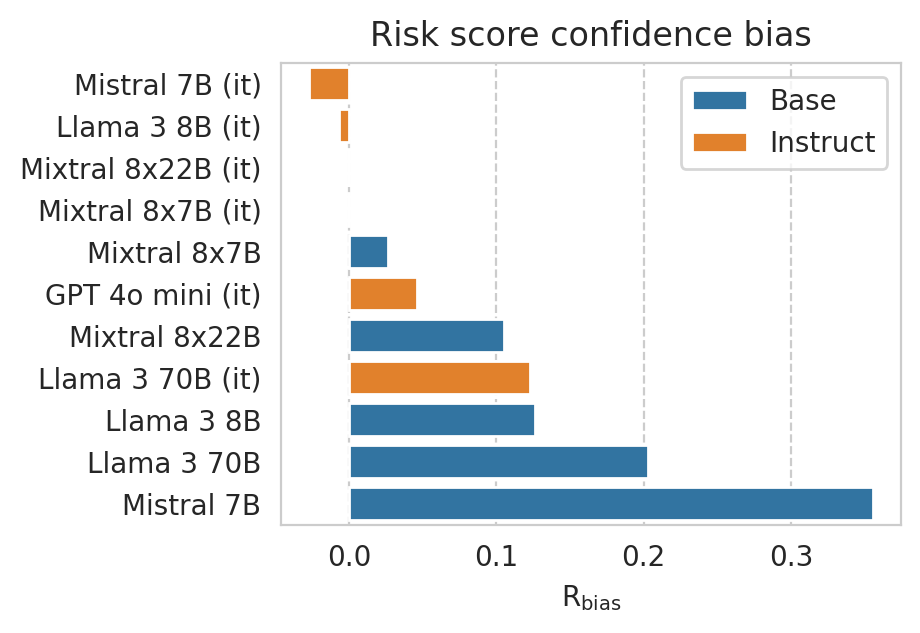
Compute risk score fairness per sub-group
[47]:
sens_attr_data = acs_dataset.data[sens_attr_col]
sens_attr_data.head(3)
[47]:
1 2
2 1
8 1
Name: RAC1P, dtype: int64
[48]:
def compute_signed_score_bias(scores_df, quantiled_bins=False, n_bins=10):
discretization_func = pd.qcut if quantiled_bins else pd.cut
scores_df["score_bin"] = discretization_func(scores_df["risk_score"], n_bins, duplicates="drop", retbins=False)
bin_categories = scores_df["score_bin"].dtype.categories
return (1 / len(scores_df)) * sum(
len(bin_data) * (bin_data["risk_score"].mean() - bin_data["label"].mean())
for bin_ in bin_categories
if len(bin_data := scores_df[scores_df["score_bin"] == bin_]) > 0
)
[49]:
def compute_signed_subgroup_score_bias(model, group: int | str) -> float:
scores_df = scores_df_map[model]
if isinstance(group, str):
group = name_to_sens_attr_map[group]
scores_df = scores_df[sens_attr_data.loc[scores_df.index] == group]
# return compute_confidence_metric(model, scores_df=scores_df)
return compute_signed_score_bias(scores_df)
def compute_calibration_fairness(model: str, priv_group: int | str, unpriv_group: int | str) -> float:
return (
compute_signed_subgroup_score_bias(model, group=priv_group)
- compute_signed_subgroup_score_bias(model, group=unpriv_group)
)
[50]:
calibration_per_subgroup_df = pd.DataFrame([
pd.Series(
{
f"{group}_score_bias": compute_signed_subgroup_score_bias(model_id, group)
for group in sens_attr_map.values()
},
name=model_id,
)
for model_id in task_df.index
])
calibration_per_subgroup_df["White_v_Black_score_bias"] = \
calibration_per_subgroup_df["White_score_bias"] - calibration_per_subgroup_df["Black_score_bias"]
calibration_per_subgroup_df["White_v_Asian_score_bias"] = \
calibration_per_subgroup_df["White_score_bias"] - calibration_per_subgroup_df["Asian_score_bias"]
calibration_per_subgroup_df["Asian_v_Black_score_bias"] = \
calibration_per_subgroup_df["Asian_score_bias"] - calibration_per_subgroup_df["Black_score_bias"]
calibration_per_subgroup_df.sample(3)
/tmp/ipykernel_3388197/3464681156.py:3: SettingWithCopyWarning:
A value is trying to be set on a copy of a slice from a DataFrame.
Try using .loc[row_indexer,col_indexer] = value instead
See the caveats in the documentation: https://pandas.pydata.org/pandas-docs/stable/user_guide/indexing.html#returning-a-view-versus-a-copy
scores_df["score_bin"] = discretization_func(scores_df["risk_score"], n_bins, duplicates="drop", retbins=False)
[50]:
| White_score_bias | Black_score_bias | Asian_score_bias | White_v_Black_score_bias | White_v_Asian_score_bias | Asian_v_Black_score_bias | |
|---|---|---|---|---|---|---|
| Mistral-7B-v0.1__ACSIncome__-1__Num | 0.353045 | 0.329428 | 0.319214 | 0.023617 | 0.033831 | -0.010215 |
| gemma-1.1-2b-it__ACSIncome__-1__Num | 0.260100 | 0.403764 | 0.202488 | -0.143664 | 0.057612 | -0.201276 |
| Yi-34B-Chat__ACSIncome__-1__Num | 0.210531 | 0.229600 | 0.212839 | -0.019069 | -0.002308 | -0.016761 |
Note: This is an example of comparing risk score bias between different sub-groups. A more detailed analysis must be conducted to draw any sort of conclusions regarding prediction fairness of the LLM.
[51]:
GROUP_A = "Asian"
# GROUP_A = "White"
GROUP_B = "Black"
# GROUP_B = "Asian"
COLUMN = f"{GROUP_A}_v_{GROUP_B}_score_bias"
plot_df = calibration_per_subgroup_df.join(results_df, how="left", validate="1:1")
plot_df = plot_df.drop(index=[id_ for id_ in plot_df.index if "gemma" in id_.lower()]) # omit Gemma models bc they're garbage :)
fig, ax = plt.subplots(figsize=(3, 3))
sns.barplot(
data=plot_df.sort_values(COLUMN, ascending=True),
x=COLUMN,
y="name",
hue="is_inst",
ax=ax,
)
handles, _ = plt.gca().get_legend_handles_labels()
plt.legend(handles=handles, labels=["Base", "Instruct"])
plt.ylabel("")
plt.xlabel("$\Delta_{SCE}$")
plt.title(
"Signed risk score bias\n"
+ r"($SCE_{" + GROUP_A
+ r"} - SCE_{" + GROUP_B
+ r"}$)"
)
plt.plot()
save_fig(fig, f"score_bias.{COLUMN}.pdf")
Saved figure to '../results/imgs/score_bias.Asian_v_Black_score_bias.numeric-prompt.pdf'
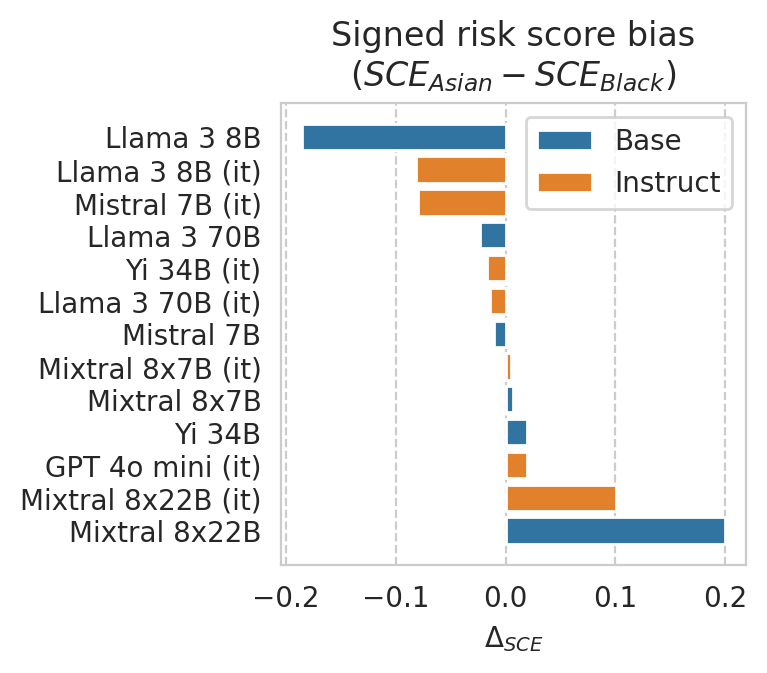
[52]:
plot_df.sort_values(COLUMN, ascending=False).head(3)
[52]:
| White_score_bias | Black_score_bias | Asian_score_bias | White_v_Black_score_bias | White_v_Asian_score_bias | Asian_v_Black_score_bias | accuracy | accuracy_diff | accuracy_ratio | balanced_accuracy | ... | name | is_inst | num_features | uses_all_features | fit_thresh_on_100 | fit_thresh_accuracy | optimal_thresh | optimal_thresh_accuracy | score_stdev | score_mean | |
|---|---|---|---|---|---|---|---|---|---|---|---|---|---|---|---|---|---|---|---|---|---|
| Mixtral-8x22B-v0.1__ACSIncome__-1__Num | 0.054322 | -0.069436 | 0.130153 | 0.123758 | -0.075831 | 0.199589 | 0.740583 | 0.148527 | 0.828562 | 0.761428 | ... | Mixtral 8x22B | False | -1.0 | True | 0.65 | 0.769300 | 0.45 | 0.740595 | 0.379947 | 0.411113 |
| Mixtral-8x22B-Instruct-v0.1__ACSIncome__-1__Num | 0.110399 | 0.055872 | 0.156710 | 0.054527 | -0.046311 | 0.100837 | 0.767882 | 0.096716 | 0.885938 | 0.770218 | ... | Mixtral 8x22B (it) | True | -1.0 | True | 0.65 | 0.769967 | 0.55 | 0.767882 | 0.298323 | 0.474955 |
| penai/gpt-4o-mini__ACSIncome__-1__Num | -0.001300 | -0.019960 | -0.000407 | 0.018661 | -0.000893 | 0.019553 | 0.777393 | 0.080767 | 0.904748 | 0.758922 | ... | GPT 4o mini (it) | True | -1.0 | True | 0.65 | 0.777302 | 0.35 | 0.775512 | 0.317359 | 0.363743 |
3 rows × 70 columns
Plots comparing different prompting schemes
[53]:
### Plot all models / i.t. / base?
IT_OR_BASE = "any"
# IT_OR_BASE = "it"
# IT_OR_BASE = "base"
### Plot which metric
METRIC = "ece"
# METRIC = "roc_auc"
[54]:
# Prepare data
df = all_results_df_original.copy()
min_max_per_task = {
task: (np.min(values), np.max(values))
for task in ALL_TASKS
if len(values := df[(df[task_col] == task) & (~df[numeric_prompt_col].isna())][METRIC]) > 0
}
# Sort models
sorted_df_index = sorted(
df.index.tolist(),
key=lambda id_: model_sort_key(id_, df),
reverse=True,
)
df = df.loc[sorted_df_index]
if IT_OR_BASE == "it":
print("Plotting IT models")
df = df[df["is_inst"] == True]
elif IT_OR_BASE == "base":
print("Plotting BASE models")
df = df[df["is_inst"] == False]
else:
print("Plotting ALL models")
df = df.sort_values(by=["is_inst", "model_size"], ascending=False)
# Data for multiple-choice prompting
df_mult_choice = df[df[numeric_prompt_col] == False].set_index(["name", task_col], drop=False)
# Data for numeric risk prompting
df_numeric = df[df[numeric_prompt_col] == True].set_index(["name", task_col], drop=False)
# Sorted list of model names
model_names = df_numeric["name"].unique().tolist()[::-1]
n_models = len(model_names)
print(f"{model_names=}")
Plotting ALL models
model_names=['Gemma 2B', 'Gemma 7B', 'Mistral 7B', 'Llama 3 8B', 'Yi 34B', 'Mixtral 8x7B', 'Llama 3 70B', 'Mixtral 8x22B', 'Gemma 2B (it)', 'Gemma 7B (it)', 'Mistral 7B (it)', 'Llama 3 8B (it)', 'Yi 34B (it)', 'Mixtral 8x7B (it)', 'Llama 3 70B (it)', 'Mixtral 8x22B (it)', 'GPT 4o mini (it)']
[55]:
import matplotlib.pyplot as plt
from matplotlib.patches import FancyArrowPatch
# Create a figure and axis
fig, axes = plt.subplots(ncols=len(ALL_TASKS), figsize=(8, n_models / 3), sharey=True)
for task_i, task in enumerate(ALL_TASKS):
# Get current plot axis
ax = axes[task_i]
# Plot arrows for each model
for i, model_name in enumerate(model_names):
curr_mult_choice_metric = df_mult_choice.loc[model_name, task][METRIC]
curr_numeric_metric = df_numeric.loc[model_name, task][METRIC]
ax.scatter(
curr_mult_choice_metric, i,
color=palette[0], marker="s",
label='Multiple-choice' if i == 0 else "",
)
ax.scatter(
curr_numeric_metric, i,
color=palette[1], marker="o",
label='Numeric' if i == 0 else "",
)
# Draw a FancyArrowPatch arrow from before to after fine-tuning
if METRIC == "ece":
curr_metric_improved = curr_numeric_metric <= curr_mult_choice_metric
else:
curr_metric_improved = curr_numeric_metric >= curr_mult_choice_metric
arrow = FancyArrowPatch(
(curr_mult_choice_metric, i), (curr_numeric_metric, i),
arrowstyle='->',
color=palette[2] if curr_metric_improved else palette[3],
mutation_scale=15,
lw=1.5,
)
ax.add_patch(arrow)
# Set axes ranges according to overall min/max values
lo, hi = min_max_per_task[task]
if METRIC == "ece":
lo = max(lo - 5e-2, 0)
hi = min(hi + 5e-2, 0.475)
elif METRIC == "roc_auc":
lo = max(lo - 5e-2, 0.475)
hi = min(hi + 4e-2, 1)
if task == "ACSIncome" and METRIC == "roc_auc":
lo = 0.58
ax.set_xlim(lo, hi)
# Set y-ticks and y-labels
ax.set_yticks(range(n_models))
ax.set_yticklabels(model_names)
# # Prettify x-axis ticks
# xticks = ax.get_xticks()
# ax.set_xticks(xticks, [f"{x}" for x in xticks])
# Add labels and title
# ax.set_xlabel('ECE')
ax.set_title(task[3:])
# Add horizontal line separating instruct and base models
if IT_OR_BASE == "any":
n_instruct_models = len(df_mult_choice[(df_mult_choice["is_inst"] == True) & (df_mult_choice[task_col] == task)])
line_y = n_instruct_models - 1.5
ax.axhline(line_y, color='black', linestyle='--', linewidth=1) #, label="instruct / base")
# Add text label near the horizontal line
if task_i > len(ALL_TASKS) - 3:
text_kwargs = dict(
horizontalalignment='right',
transform=ax.get_yaxis_transform(), # Use axis coordinates for y-axis
fontsize=9, color='black',
)
ax.text(1, line_y + 0.1, 'i.t.', verticalalignment='bottom', **text_kwargs)
ax.text(1, line_y - 0.1, 'base', verticalalignment='top', **text_kwargs)
# Add legend for marker
axes[0].legend(loc="upper right", bbox_to_anchor=(-0.15, 0.01), title="Prompting scheme")
# X-axis label
if METRIC == "ece":
x_axis_label = "Expected Calibration Error (ECE)"
elif METRIC == "roc_auc":
x_axis_label = "Predictive Power (ROC AUC)"
fig.text(0.5, 0.02 if IT_OR_BASE == "any" else -0.04, x_axis_label, horizontalalignment="center", verticalalignment="center")
# Save figure
save_fig(fig=fig, name=f"{METRIC}_comparison_diff_prompts.{IT_OR_BASE}-models.pdf", add_prompt_suffix=False)
# Show plot
plt.show()
Saved figure to '../results/imgs/ece_comparison_diff_prompts.any-models.pdf'
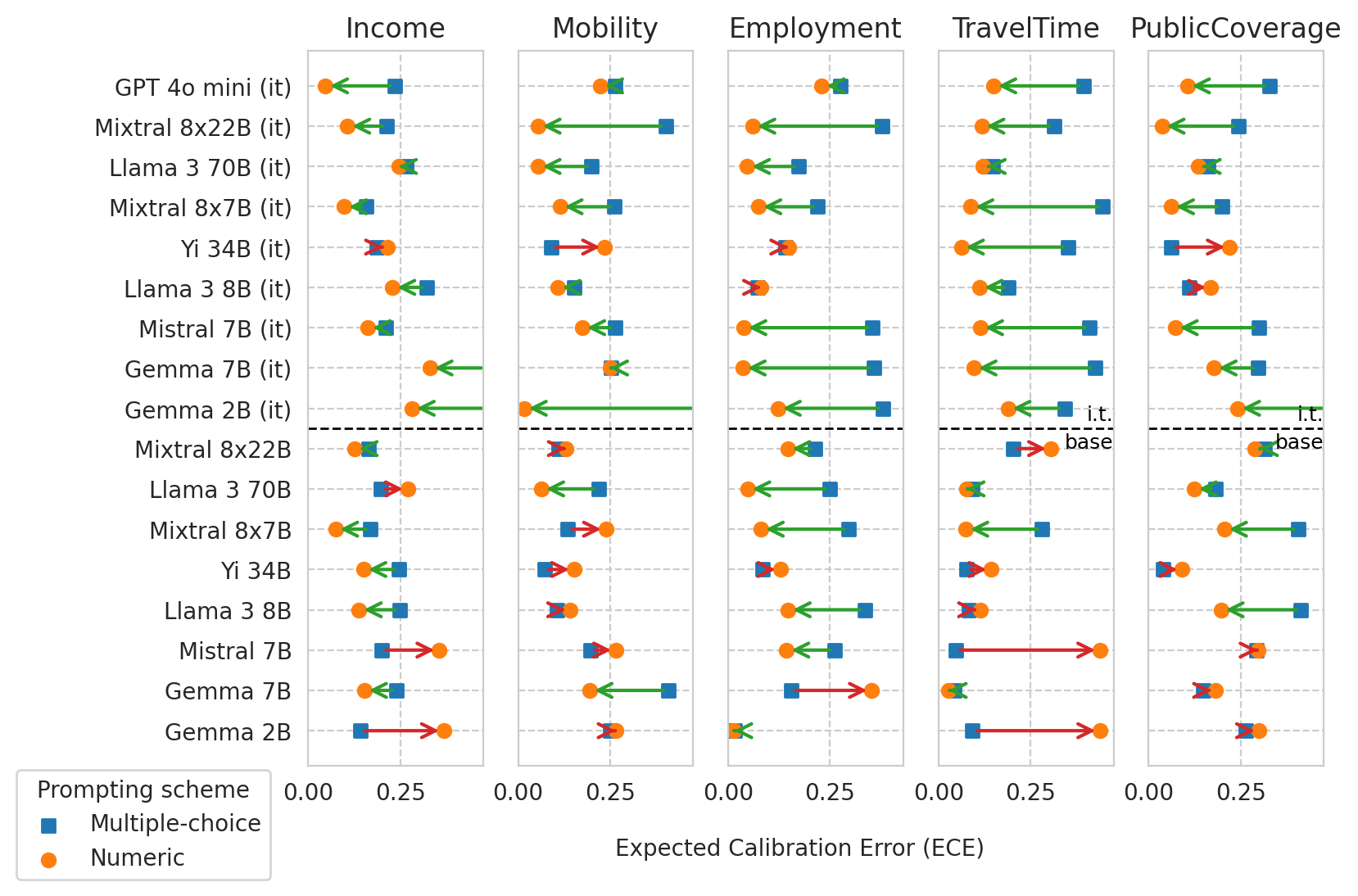
Scatter plot of ECE vs AUC for a few models (before and after numeric prompting)
[56]:
X_METRIC = "ece"
Y_METRIC = "roc_auc"
# Filter out small models
df_mult_choice = df_mult_choice[df_mult_choice["model_size"] > 50]
df_numeric = df_numeric[df_numeric["model_size"] > 50]
fig, axes = plt.subplots(ncols=len(ALL_TASKS), figsize=(len(ALL_TASKS) * 2.6, 2.2), gridspec_kw=dict(wspace=0.4))
unique_model_names = df_mult_choice.name.unique()
markers = dict(zip(unique_model_names, ["s", "o", "D", "P", "X", "<", ">"]))
for task_i, task in enumerate(ALL_TASKS):
# Create a figure and axis
# fig, ax = plt.subplots(figsize=(2.5, 2.5))
ax = axes[task_i]
# Plot arrows for each model
for i, model_name in enumerate(df_mult_choice.name.unique()):
# Get data for each plotting scheme
curr_mult_choice_row = df_mult_choice.loc[model_name, task]
curr_numeric_row = df_numeric.loc[model_name, task]
# Get points to plot
curr_mult_choice_point = (curr_mult_choice_row[X_METRIC], curr_mult_choice_row[Y_METRIC])
curr_numeric_point = (curr_numeric_row[X_METRIC], curr_numeric_row[Y_METRIC])
# Plot point for multiple-choice prompting
ax.scatter(
*curr_mult_choice_point,
color=palette[0], marker=markers[model_name],
label='Multiple-choice' if i == 0 else "",
)
# Plot point for numeric-style prompting
ax.scatter(
*curr_numeric_point,
color=palette[1], marker=markers[model_name],
label='Numeric' if i == 0 else "",
)
if curr_numeric_point[0] <= curr_mult_choice_point[0] and curr_numeric_point[1] >= curr_mult_choice_point[1]:
arrow_color = palette[2]
elif curr_numeric_point[0] > curr_mult_choice_point[0] and curr_numeric_point[1] < curr_mult_choice_point[1]:
arrow_color = palette[3]
else:
arrow_color = "grey"
# Draw a FancyArrowPatch arrow from before to after fine-tuning
arrow = FancyArrowPatch(
curr_mult_choice_point, curr_numeric_point,
arrowstyle='->',
color=arrow_color,
mutation_scale=15,
lw=1,
ls="--",
)
ax.add_patch(arrow)
### Plot configs
# Add labels and title
ax.set_title(task[3:])
ax.set_xlabel("ECE")
if task_i == 0:
ax.set_ylabel("AUC")
# Create custom global legend
from matplotlib.lines import Line2D
# Create a global legend for markers (model names)
marker_handles = [Line2D([0], [0], marker=markers[model], color='w', markerfacecolor='black', markersize=8, label=model) for model in unique_model_names]
# Create a global legend for colors (prompting schemes)
color_handles = [
Line2D([0], [0], marker='o', color='w', markerfacecolor=palette[0], markersize=8, label="Multiple-choice"),
Line2D([0], [0], marker='o', color='w', markerfacecolor=palette[1], markersize=8, label="Numeric")
]
# Position the legends outside the subplots
fig.legend(handles=marker_handles, title="Models", loc='upper left', bbox_to_anchor=(0.13, -0.12), ncol=min(4, len(unique_model_names)))
fig.legend(handles=color_handles, title="Prompting Scheme", loc='upper right', bbox_to_anchor=(0.9, -0.12), ncol=2)
# Save figure
save_fig(fig=fig, name=f"comparison_diff_prompts.{IT_OR_BASE}-models.pdf", add_prompt_suffix=False)
plt.show()
Saved figure to '../results/imgs/comparison_diff_prompts.any-models.pdf'
